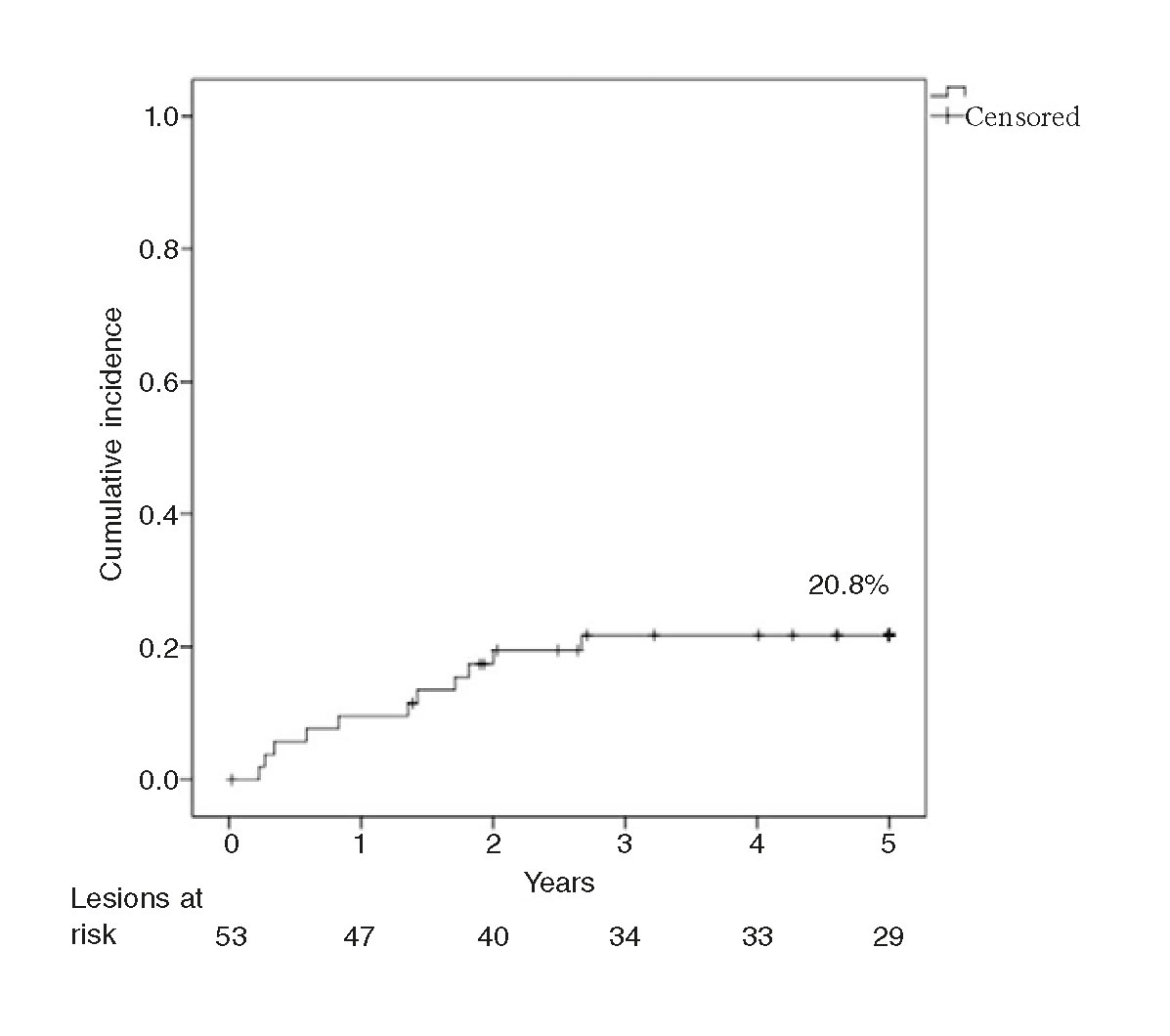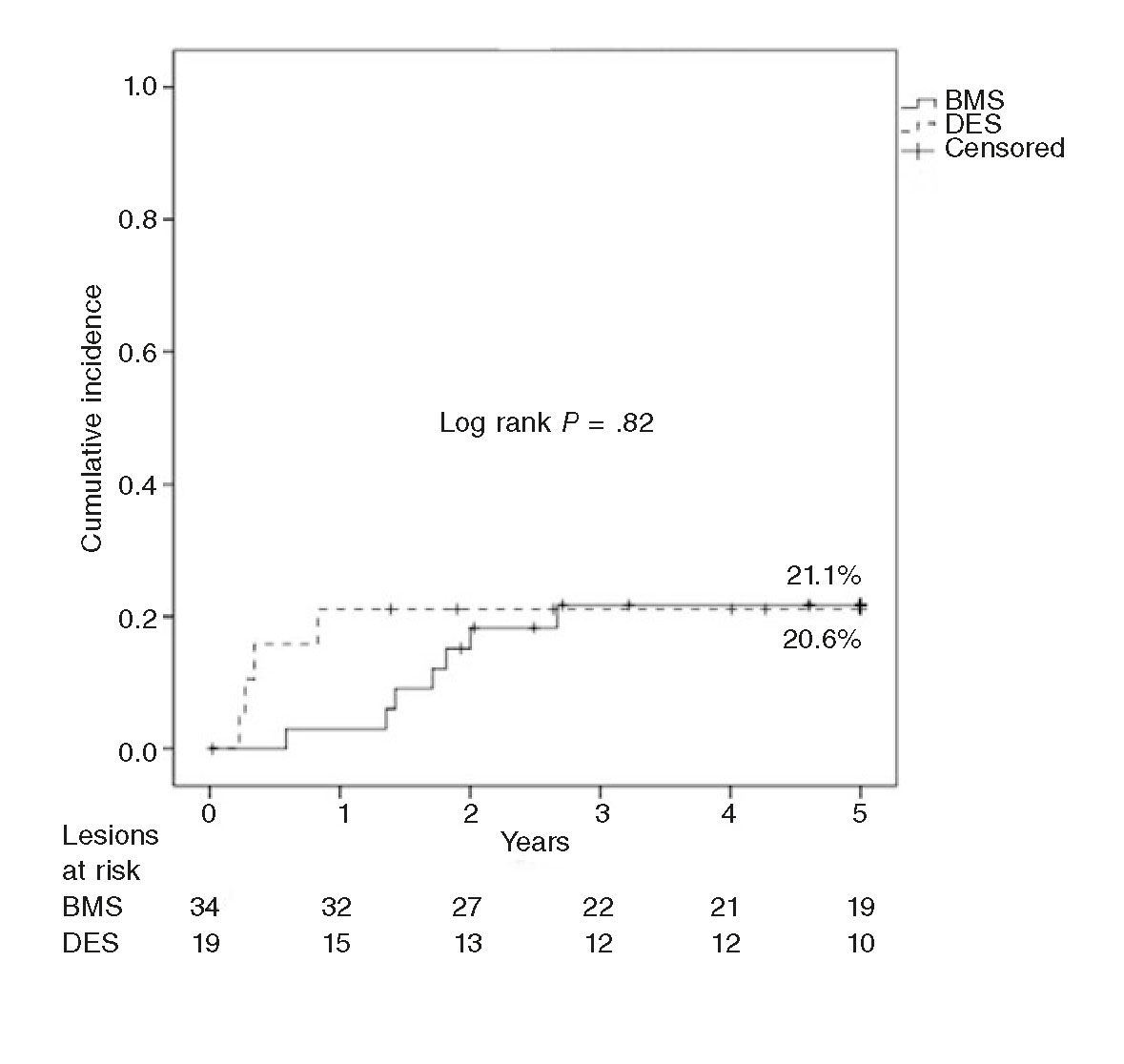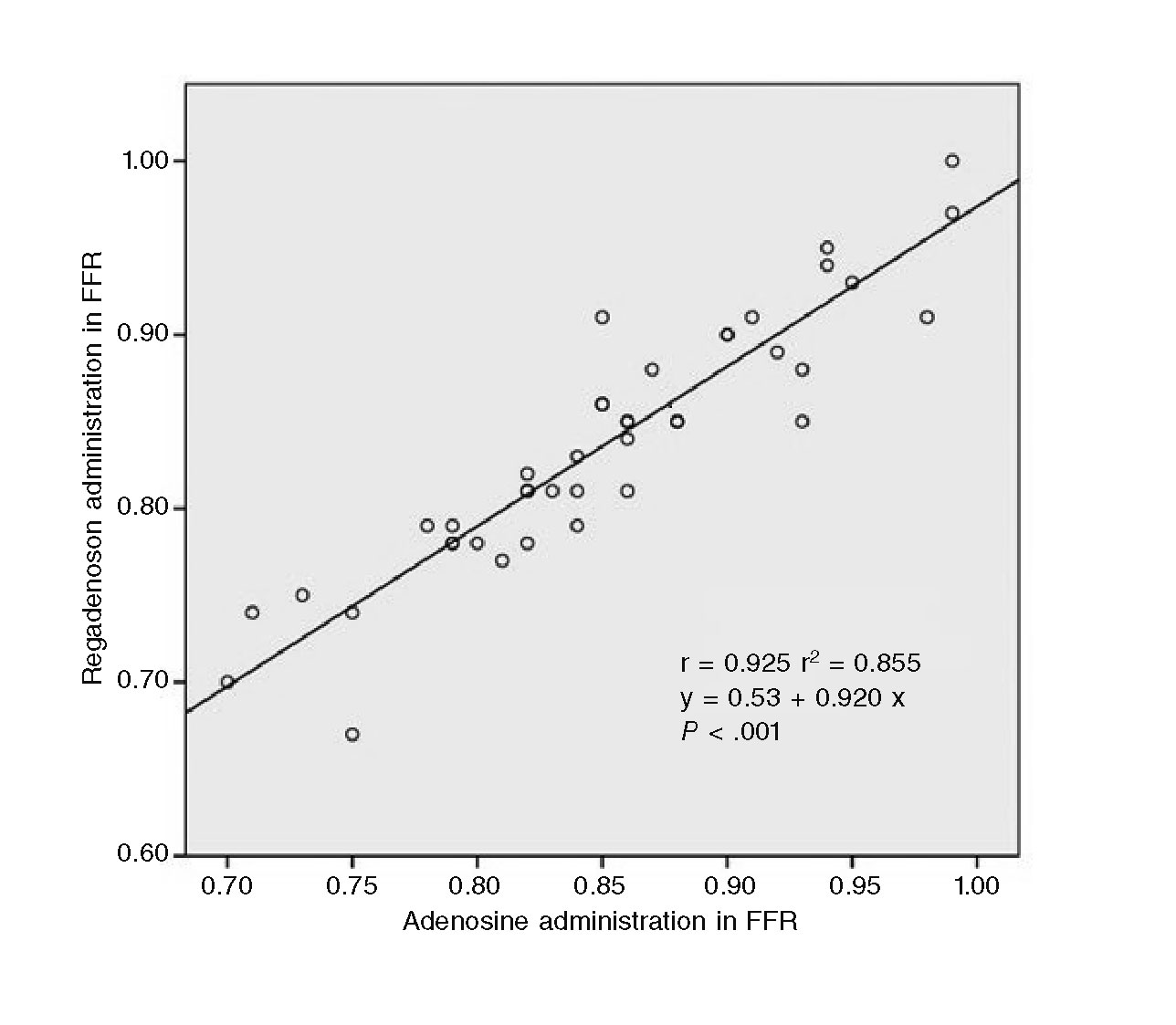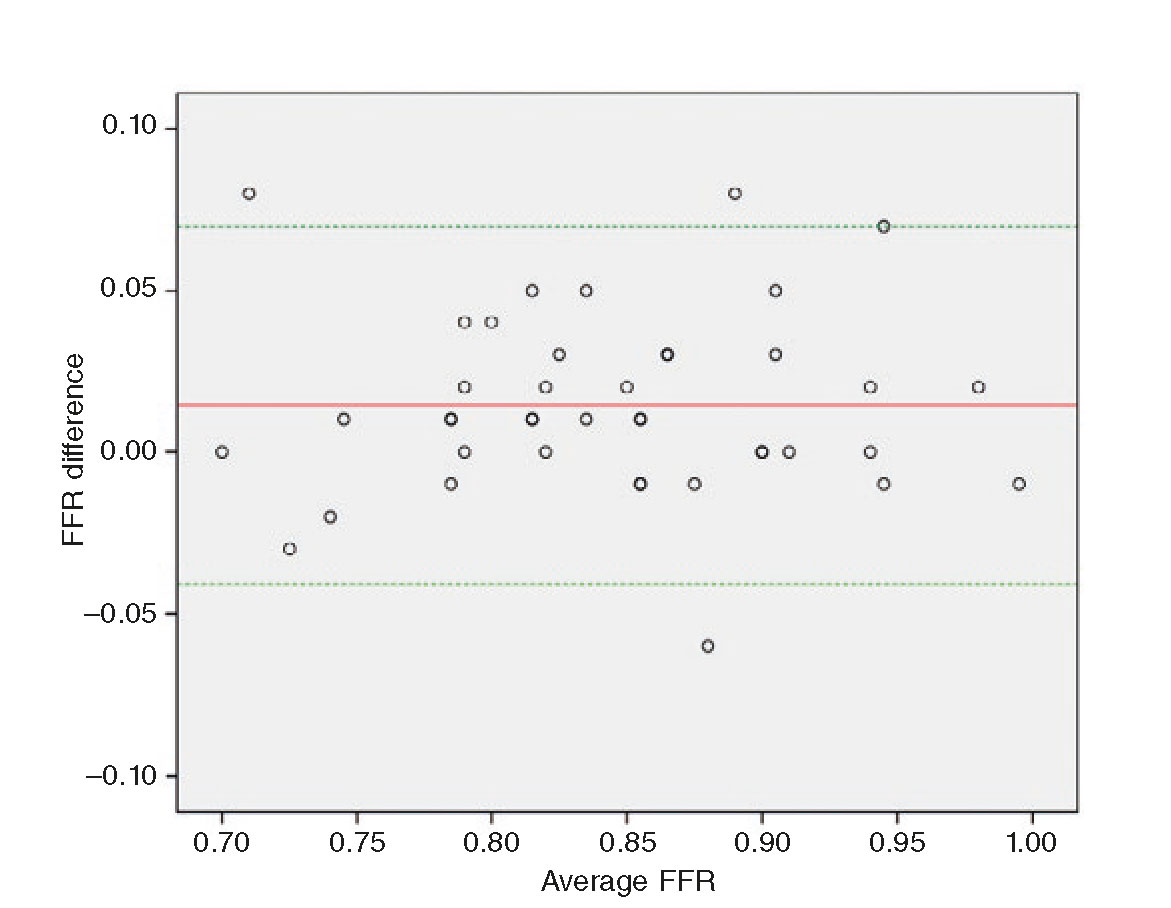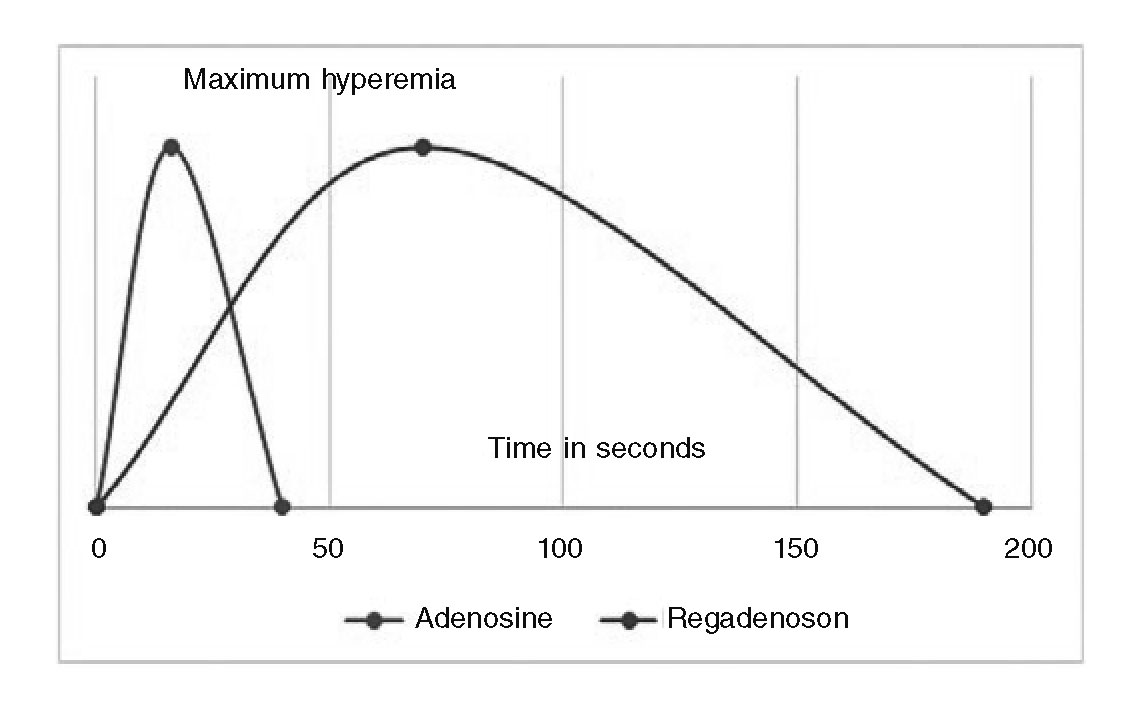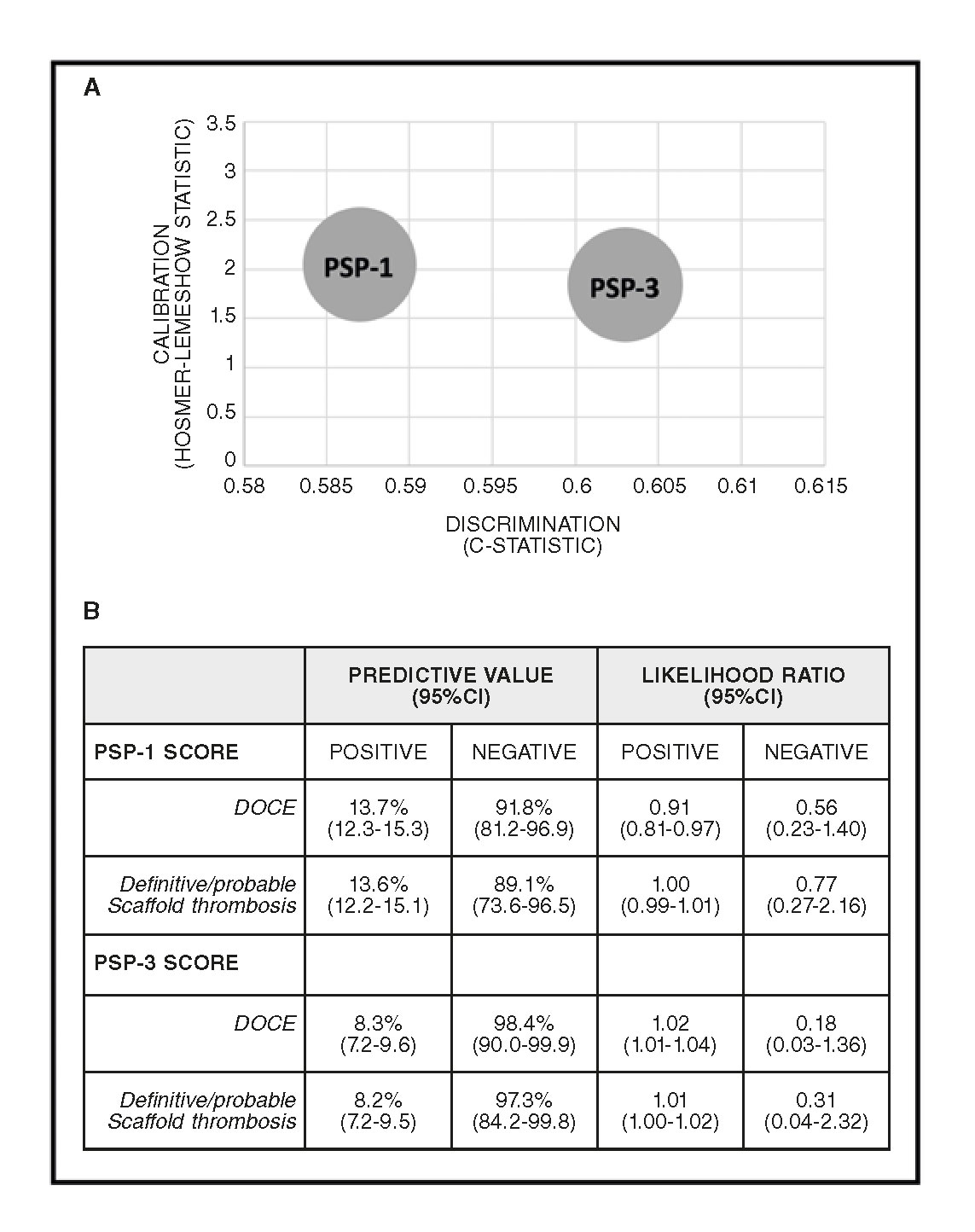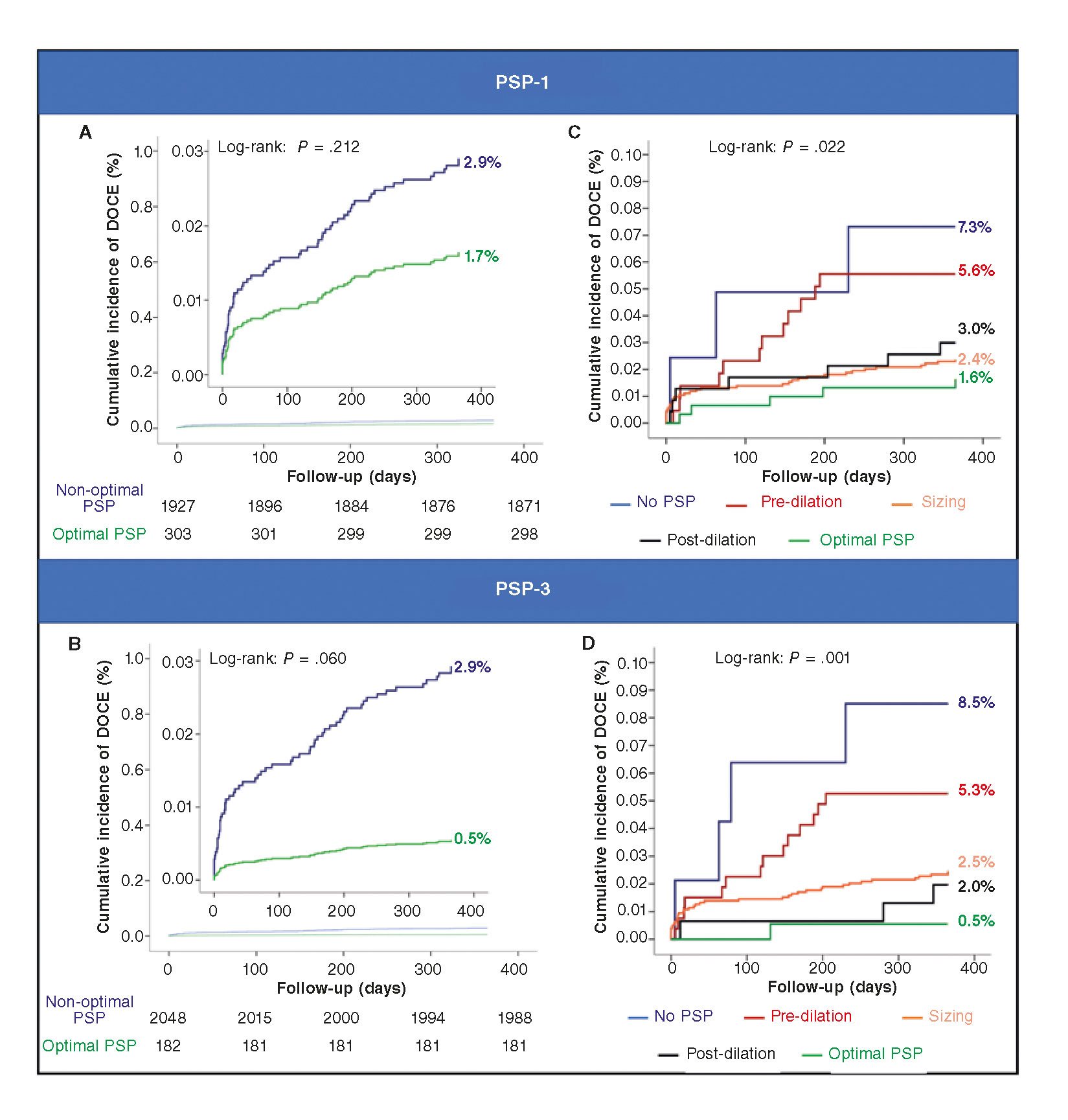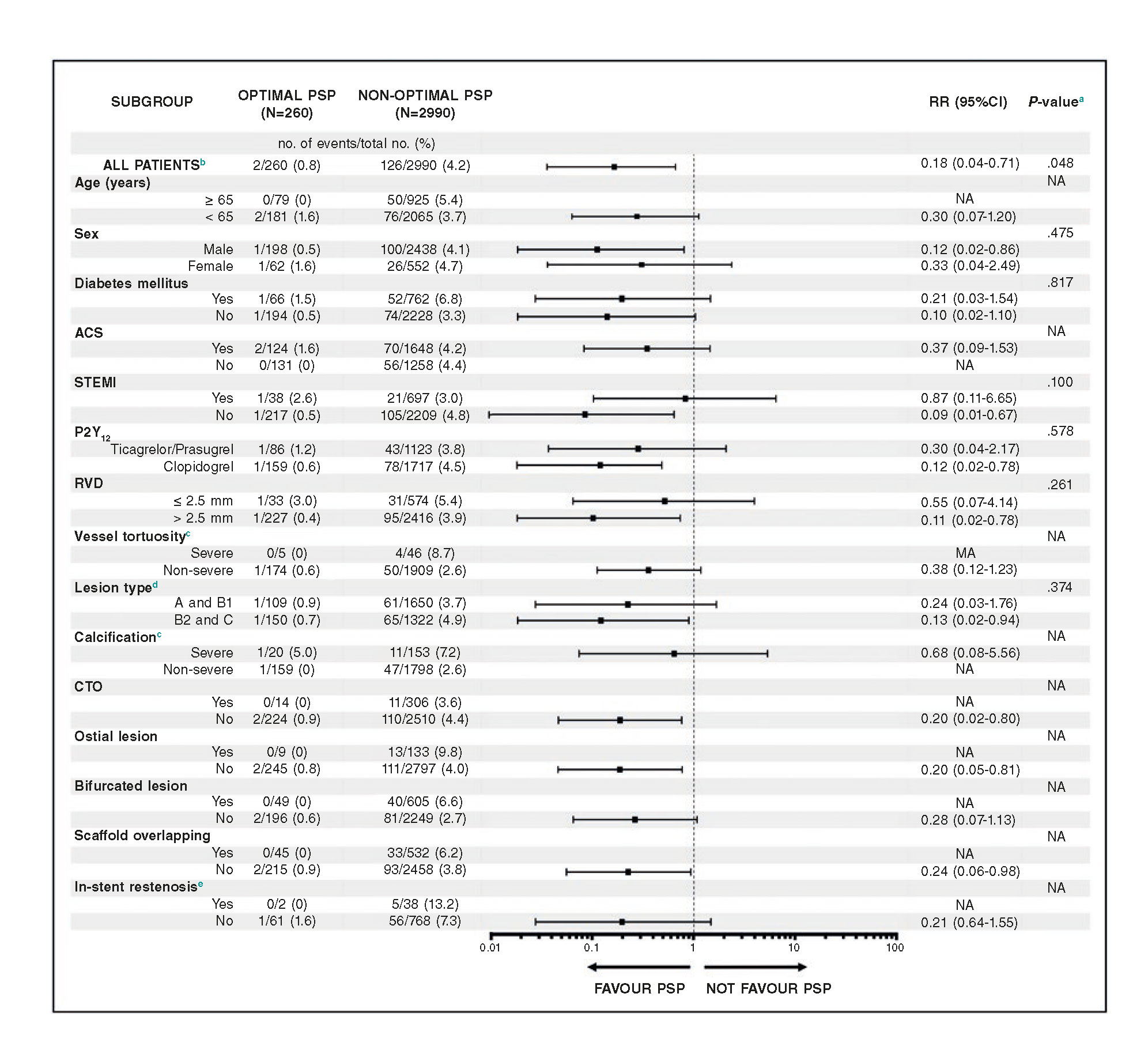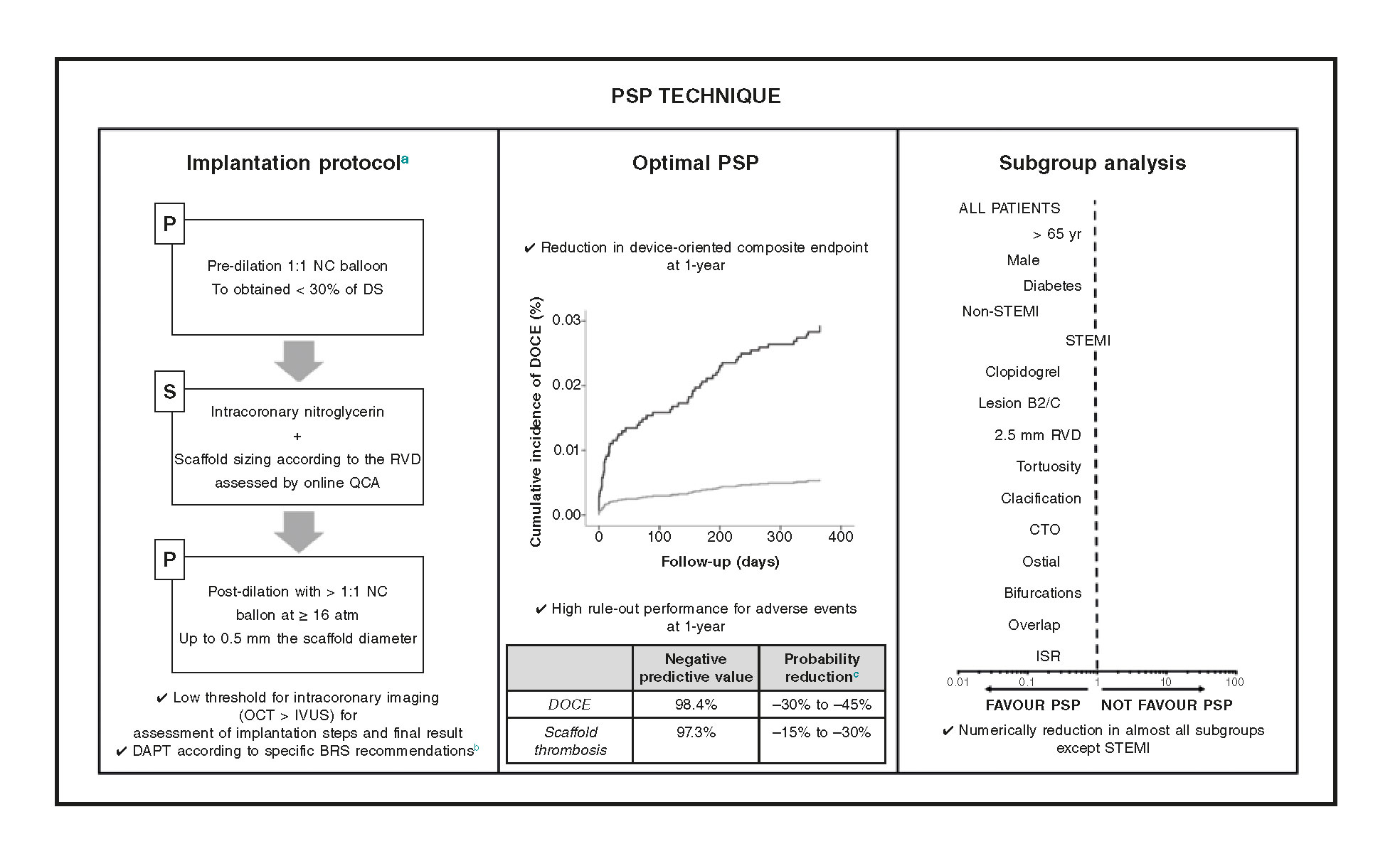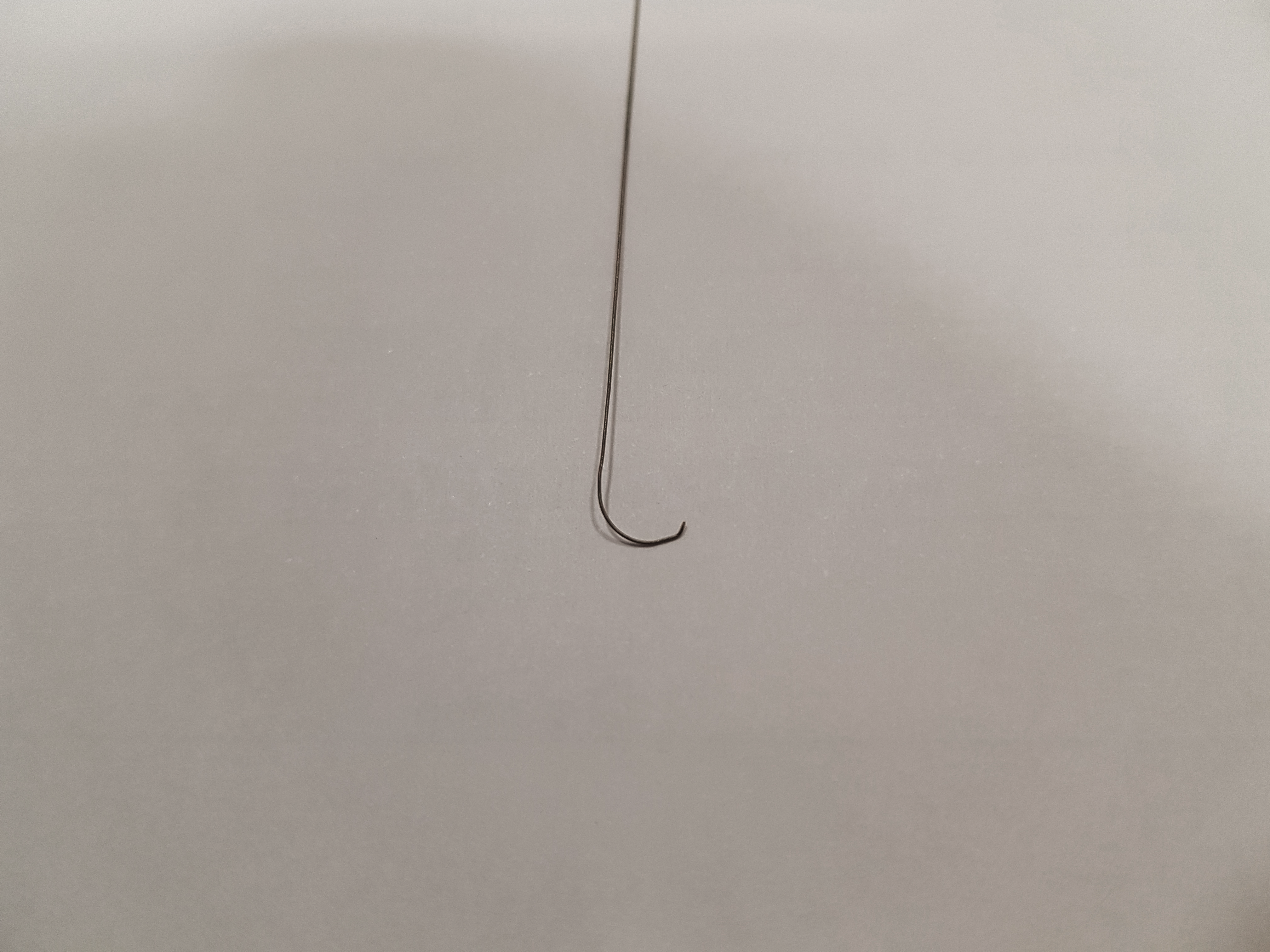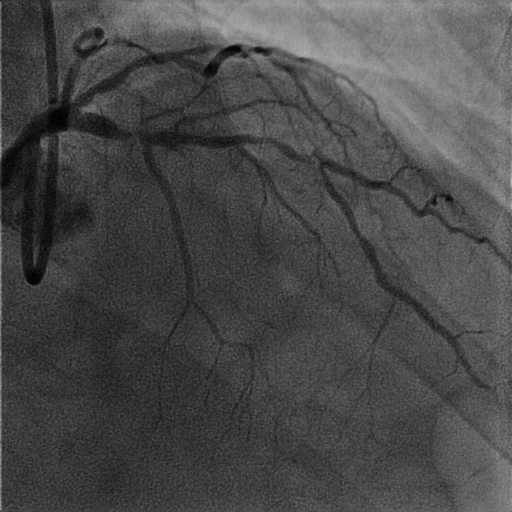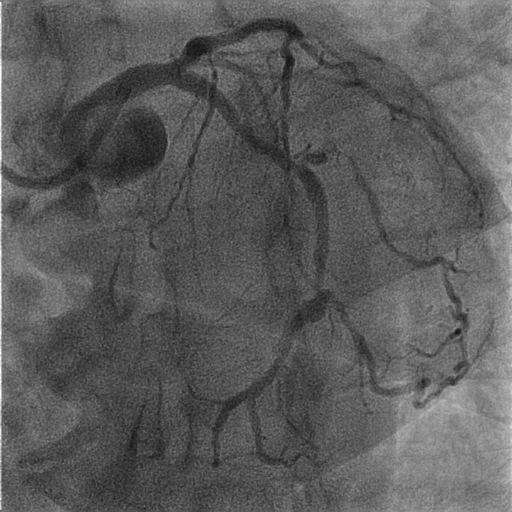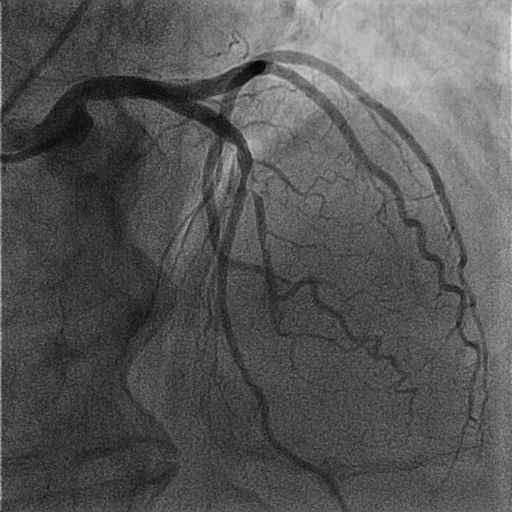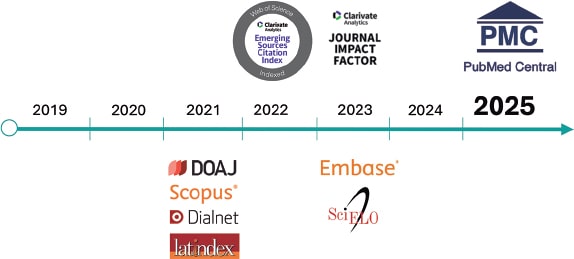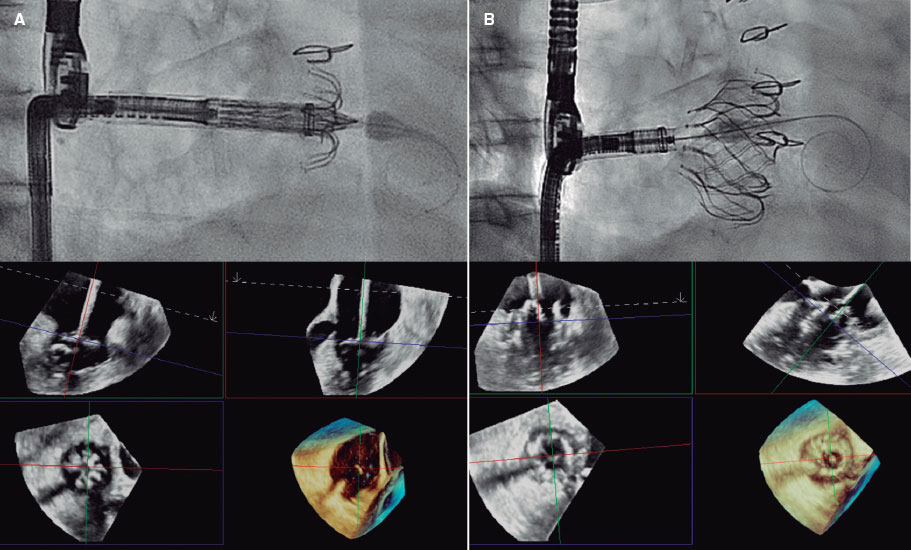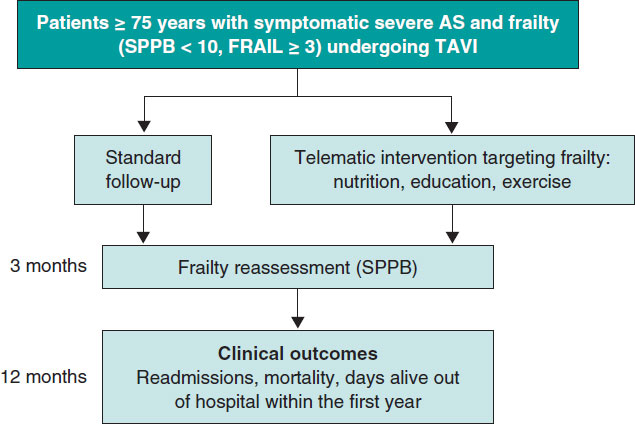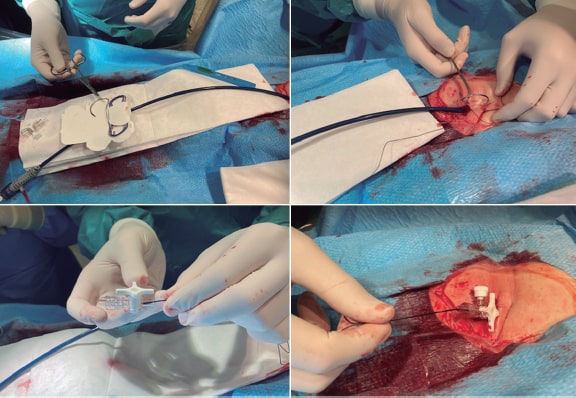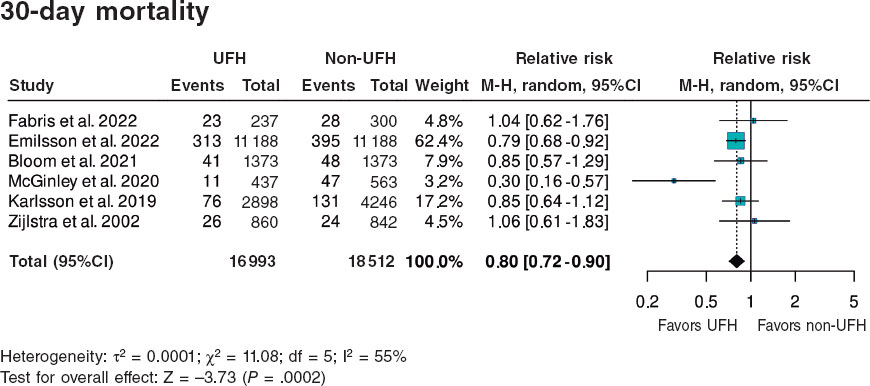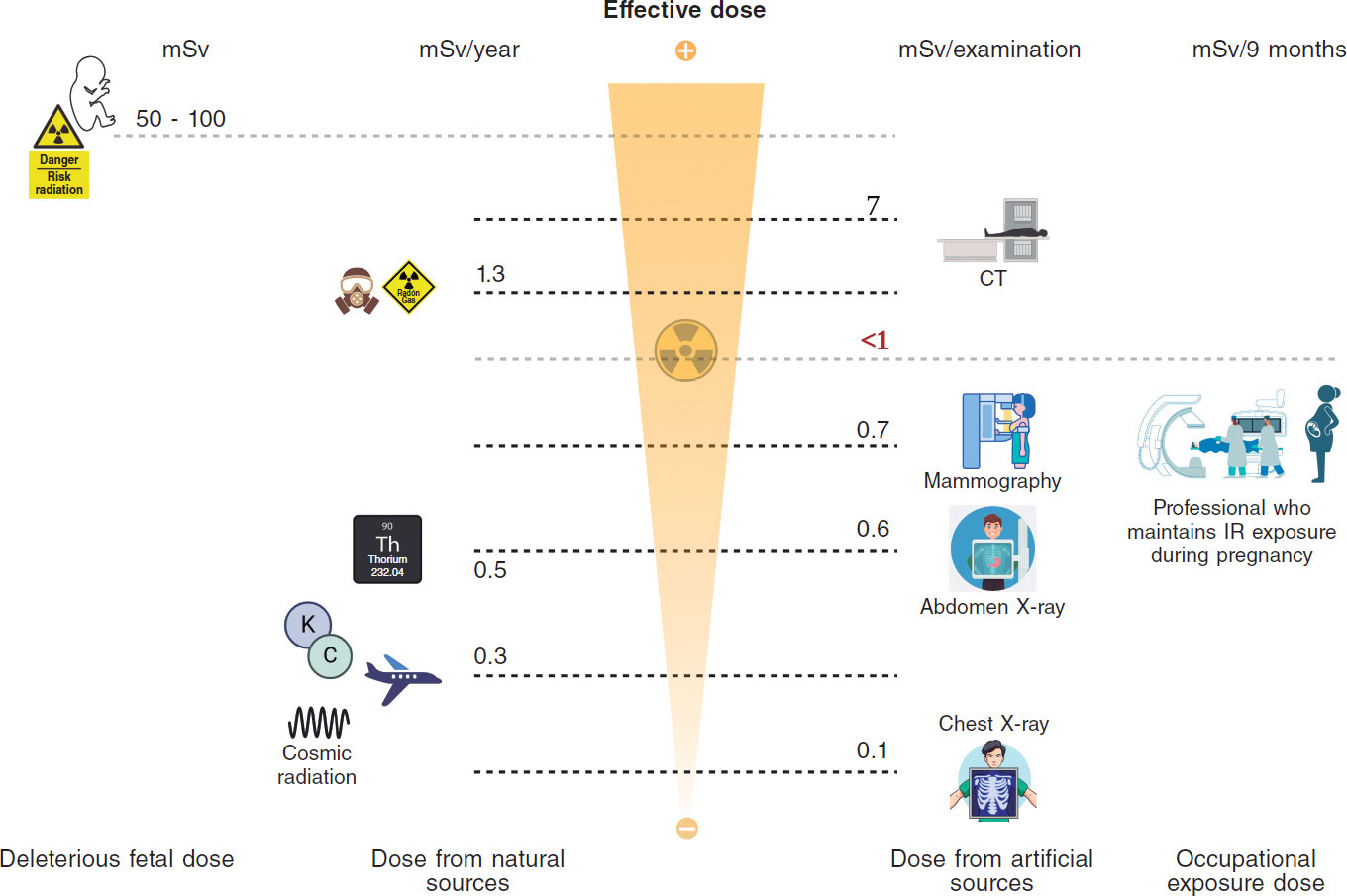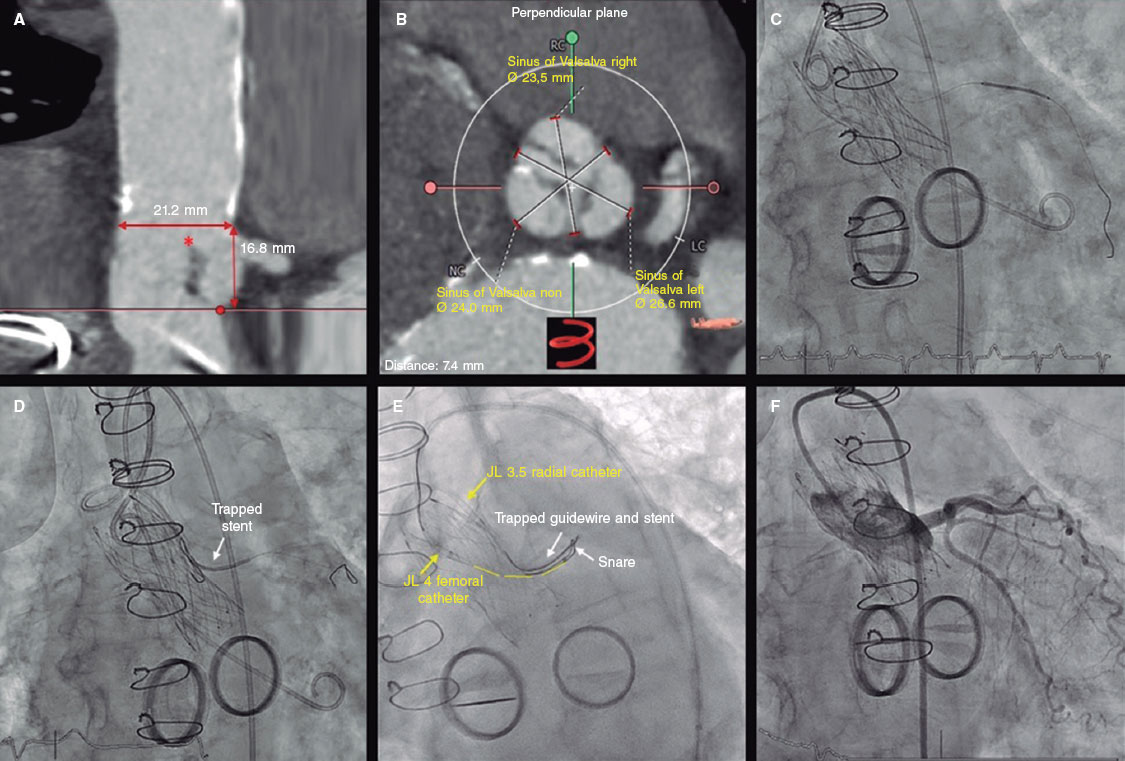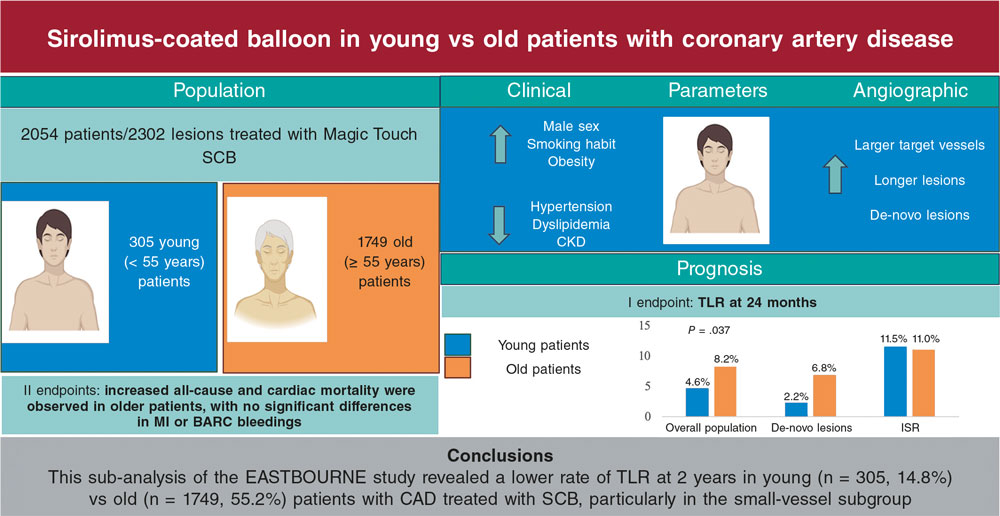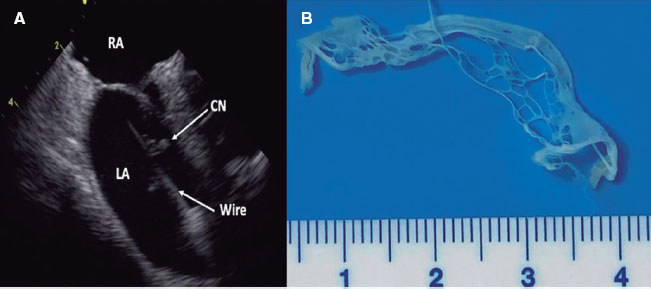Article
Ischemic heart disease and acute cardiac care
REC Interv Cardiol. 2019;1:21-25
Access to side branches with a sharply angulated origin: usefulness of a specific wire for chronic occlusions
Acceso a ramas laterales con origen muy angulado: utilidad de una guía específica de oclusión crónica
Servicio de Cardiología, Hospital de Cabueñes, Gijón, Asturias, España
ABSTRACT
Introduction and objectives: Today it has become increasingly common to perform procedures without withdrawing oral anticoagulation. However, the need to withdraw oral anticoagulants prior to cardiac catheterization in patients chronically anticoagulated (OACs) remains controversial. We evaluated the efficacy and safety of performing transradial catheterization in outpatients without withdrawing direct-action oral anticoagulants (DOACs).
Methods: Prospective and observational study where 270 patients who underwent elective transradial cardiac catheterization were included from January 2013 through November 2017, divided into 3 groups of 90 patients based on their anticoagulant intake: group A (without OAC), with group B (with vitamin K antagonist), and group C (with DOACs), and matched according to the date of completion. In no case was the OAC discontinued before the procedure. We evaluated the complications of radial access within the first 24 h and 1 month after the procedure.
Results: The group of patients on DOACs had a higher proportion of men compared to the vitamin K antagonist group (71.1% vs 47.8%; P = .01) and patients were younger in the group without OAC (63.45 ± 11.47 vs 70.22 ± 9.35; P = .03). Group B had a lower percentage of diabetic patients (22.2% vs 36.67% in group C, P = .03). In group A, patients were more prone to having a history of ischemic heart disease compared to the groups of anticoagulated patients (27.84% vs 14.44% in group C, P = .028) in addition to a more frequent intake of antiplatelet drugs. Radial access was the access of choice in most patients (98.2%). There were no significant differences when it comes to vascular access complications among the groups being the rate of hematoma and/or bleeding at discharge equal to 1.1% in the DOACs group and the arterial occlusion rates both at discharge and at 1 month between 0% and 2.2%.
Conclusions: In our experience performing transradial diagnostic cardiac catheterizations without discontinuation of DOACs is safe, with low rates of thrombotic and hemorrhagic complications, without any differences with vitamin K antagonist and no OAC.
Keywords: DOACs. NOACs. Direct vitamin K anticoagulants. Non-vitamin K anticoagulants. Cardiac catheterization. Transradial.
RESUMEN
Introducción y objetivos: Actualmente es cada vez más habitual realizar procedimientos sin retirar la anticoagulación oral (ACO), pero la necesidad o no de suspender la ACO antes del cateterismo cardiaco sigue siendo una cuestión controvertida. Se evalúan la eficacia y la seguridad de la realización de un cateterismo transradial en pacientes ambulatorios sin retirar los anticoagulantes orales de acción directa (ACOD).
Métodos: Estudio observacional, prospectivo, que incluye 270 pacientes sometidos a cateterismo transradial electivo desde enero de 2013 hasta noviembre de 2017, divididos en 3 grupos de 90 pacientes: grupo A (sin ACO), grupo B (con antagonista de la vitamina K), grupo C (con ACOD), emparejados según la fecha de realización del cateterismo. No se suspendió la ACO antes del procedimiento. Se evalúan las complicaciones del acceso radial en las primeras 24 h y un mes después del cateterismo.
Resultados: Había más varones tratados con ACOD que con un antagonista de la vitamina K (71,1 frente a 47,8%; p = 0,01) y los pacientes eran más jóvenes en el grupo sin ACO (63,45 ± 11,47 frente a 70,22 ± 9,35 años; p = 0,03). En el grupo B hubo menos diabéticos (22,2 frente a 36,67% en el grupo C; p = 0,03). En el grupo A, los pacientes tenían más antecedentes de cardiopatía isquémica que los pacientes con anticoagulación (27,84 frente a 14,44% en el grupo C; p = 0,028), además de la toma concomitante de fármacos antiplaquetarios. El acceso fue radial en la mayoría de los pacientes (98,2%). No hubo diferencias significativas en las complicaciones del acceso vascular, con una tasa de hematoma o hemorragia al alta del 1,1% en el grupo con ACOD y tasas de oclusión arterial tanto al alta como al mes del 0-2,2%.
Conclusiones: En nuestra experiencia, la realización de un cateterismo diagnóstico transradial sin interrupción de los ACOD es seguro, con tasas bajas de complicaciones trombóticas y hemorrágicas, sin diferencias respecto a los pacientes en tratamiento con un antagonista de la vitamina K o sin ACO.
Palabras clave: ACOD. NACO. Anticoagulantes de acción directa. Anticoagulantes no antagonistas de la vitamina K. Cateterismo cardiaco. Transradial.
Abbreviations: BT: bridging theraphy. COAC: chronic oral anticoagulation. DOAC: direct-acting oral anticoagulants. VKA: vitamin K antagonists.
INTRODUCTION
The number of patients who receive chronic oral anticoagulation (COAC) is huge, and is expected to increase in the future due to the overall aging of the population and the increased incidence of conditions that will require COAC.
The prevalence of COAC among patients with coronary disease who undergo percutaneous coronary interventions is between 6% and 8%.1 Most cases are due to the concomitant presence of atrial fibrillation with moderate-to-high embolic risk.
On the other hand, up to between 20% and 30% of the patients with atrial fibrillation and an indication of COAC present with coronary disease.2 Taking into account that the prevalence of atrial fibrillation in the population is between 1% and 2%, up to 1-2 million anticoagulated patients in Europe will end up needing one coronary angiography procedure.
There is, therefore, a significant number of patients receiving COAC with vitamin K antagonists (VKA) or one of the most recent direct-acting oral anticoagulants (DOACs, Apixaban, Rivaroxaban, Dabigatran or Edoxaban) that require coronary angiography. The routine practice with these patients is very variable, but traditionally patients with COAC have discontinued the drug and moved on to bridging therapy (BT) with low molecular weight heparin a few days before and a few days after the procedure.3 However, an increase of hemorrhagic events with this strategy in interventional procedures and higher morbidity and mortality in these patients due to bleeding or prothrombotic situations due to the discontinuation and reset of anticoagulants has been reported.2,4-7
The safety of diagnostic catheterization through radial access under treatment with acenocoumarol (VKA) has been demonstrated previously. In our group, the safety profile of VKA has already been evaluated in this type of patients in the past.8 Since there is less evidence in patients on DOACs, with this work we want to provide new evidence on this regard, given the increasing number of patients anticoagulated with these new drugs over the last few years.
In this study, we report our experience and we evaluate the safety profile of transradial diagnostic cardiac catheterizations in patients on DOACs who were discharged the same day they underwent the procedure. Also, we compared these patients with other treated with heparin during catheterization and patients on COAC with VKA.
METHODS
Study population
This is a prospective and observational study where 270 patients who underwent elective transradial cardiac catheterizations were included from January 2013 through November 2017, divided into 3 groups of 90 patients based on the intake of VKA, DOACs or without oral anticoagulant treatment, and then matched according to the date of completion. All patients who underwent diagnostic catheterization and were having DOACs during this period were recruited. As control groups, we decided to recruit the next patient who underwent a diagnostic catheterization without anticoagulant treatment and the next one that was receiving acenocoumarol without withdrawal.
In no case was oral anticoagulant therapy withdrawn prior the procedure.
In patients treated with DOACs, 20 were on dabigatran (22.22%), 38 patients on rivaroxaban (42.22%), 29 patients on apixaban (32.22%) and 3 patients on edoxaban (3.33%).
In patients undergoing VKA treatment with international normalized ratio (INR) values < 2 (underdosing) and in DOAC patients who missed their last dose by mistake, intraprocedural sodium heparin was prescribed at a dose of 2500-5000 international units in one intra-arterial bolus. In our series, 21.3% of the patients treated with VKA received underdosing (INR < 2) and, therefore, needed heparin. In this group of patients, the mean INR was 2.5 ± 0.06. The range was 1.3-4.3 (75% INR > 2.1).
In a former article of our group8 we described the methodology of outpatient catheterizations at our center that we detail here.
Patients without COAC received the standard anticoagulant therapy with one intraarterial bolus of 5000 IU of unfractionated heparin (the routine clinical practice at our center). Also, 2.5 mg of verapamil were administered intraarterially to all patients to prevent any radial spasms.
They underwent elective transradial cardiac catheterization with same-day discharge, after removing the compression bandage and achieving hemostasis. All cases were conducted through one hydrophilic 5-Fr sheath. Hospitalized patients who underwent diagnostic catheterization were excluded as well those in whom an angioplasty procedure was anticipated.
All procedures were conducted in a single interventional cardiology unit with huge experience using transradial access (over 90% of all cases annually) and with an active program of same-day discharge outpatient cardiac catheterizations.8,9
Procedural characteristics
All patients are welcome at a room near the interventionist laboratory and are evaluated by a nurse specialized in their monitoring and follow-up. This nurse is in charge of informing the patients, collecting the patient’s background, verifying the doses and time of the last COAC intake, and estimating the INR in patients on acenocoumarol. After informing the patient and collecting the informed consent, the best vascular access is selected, assessing the quality of the pulse and performing the Barbeau test.
Once the procedure is completed, the radial compression is performed using the patent hemostasis technique for, at least, 2 h. Radial patency and possible complications are assessed in this room prior to the patient’s discharged. The complications and outcomes of the vascular approach we assessed were: acute bleeding (with need to extend the length of compression), hematoma 5-10 cm at discharge, radial patency at discharge, bleeding and/or hematoma at 24 h, radial patency at 1 month and the presence of other unusual complications (pseudo-aneurysms, fistulas, arterial perforations, or compartment syndrome). For hematoma classification, the EASY criteria were used.10 The compression of the vascular access was made with swab and elastic bands for 2 h using the patent hemostasis technique11 where distal permeability is verified through plethysmography. Additionally, a 30 min extra-compression was performed if the puncture bled when the bandage was removed. In order to assess radial patency after the removal of compression, the test described by Barbeau et al. was used.12 was used here. Artery occlusion was defined by type D response (no recovery of the curve of pulse in 2 min). All patients were contacted via telephone over the following 24 h after the procedure to determine delayed local complications, and they were all followed during 1 month to determine the access occlusion.
Statistical analysis
Data are expressed as absolute rate and percentage for qualitative variables. Quantitative variables are expressed as mean (standard deviation) or median 25–75 interquartile range depending on variable distribution. Group comparisons were analyzed using the Student t test or its non-parametric equivalent; the Man– Whitney U-test for continuous variables, and chi-square test or Fisher’s exact test were used for the categorical variables. Statistical significance was defined as P values < .05. The statistical analysis was conducted using the statistical package SPSS 19.0 (SPSS, Inc.; Chicago, Illinois, United States).
RESULTS
The patients included in the study were assigned to three groups of 90 individuals each and matched by date of procedure: one group without oral anticoagulation (group A), another group with anti-vitamin K treatment (group B) and another with direct-acting anticoagulants (group C).
The indication of oral anticoagulation in group B mostly corresponds to patients with atrial fibrillation (74.4%), 26.7% of patients had valvular disease and 5.6% of them were carriers of mechanical prostheses; the remaining patients received anticoagulation due to a past medical history of embolism (5.6%), dilated cardiomyopathy (1.1%) and other causes.
The baseline characteristics of our patients are shown on table 1. The group treated with DOACs had a higher proportion of men than the VKA group (71.1% vs 47.8%; P = .01) and patients were younger in the group without oral anticoagulation (63.4 ± 11.5 vs 70.2 ± 9.3; P = .03). Group B had a lower percentage of diabetic patients (22.2% vs 36.67% in group C, P = .03). Group A patients had a past medical history of ischemic heart disease more frequently than the groups of anticoagulated patients (27.84% vs 14.44% in group C, P = .028) and therefore, they had undergone previous catheterization using the same access in higher percentages (20% group A vs 5.5% in group C, P = .04).
Table 1. Demographic and procedural baseline characteristics
| Variable | Total | Group A: no OAC (n = 90) | Group B: VKA (n = 90) | Group C: DOACs (n = 90) | P value |
|---|---|---|---|---|---|
| Age (years), median ± SD | 68.59 ± 10.63 | 63.45 ± 11.47 | 72.09 ± 8.97 | 70.22 ± 9.35 | .03a NSb NSc |
| Men (%) | 62.6 | 68.9 | 47.78 | 71.1 | NSa .001b 041c |
| Hypertension (%) | 75.9 | 83.33 | 67.78 | 76.67 | NSa NSb NSc |
| Diabetes mellitus (%) | 32.2 | 37.78 | 22.22 | 36.67 | NSa .03b .048c |
| Dyslipidemia (%) | 48.5 | 53.33 | 52.22 | 40 | NSa NSb NSc |
| Smoking (%) | 10 | 10 | 10 | 10 | NSa NSb NSc |
| BMI (kg/m2) , median ± SD | 30.10 ± 4.62 | 30.11 ± 4.45 | 29.22 ± 4.77 | 30.98 ± 4.51 | NSa NSb NSc |
| Prior isquemic heart disease | 17 | 27.78 | 8.89 | 14.44 | .028a NSb NSc |
| ASA treatment | 79 | 65 | 3 | 11 | < .0005a .048b < .0005c |
| Clopidogrel treatment | 25 | 21 | 0 | 4 | < .0005a NSb NSc |
| Prior catheterization same access (%) | 11.5 | 20 | 8.89 | 5.55 | 04a NSb .031c |
|
ASA, acetylsalicylic acid; BMI, body mass index; DOAC, direct-acting oral anticoagulants; NS, non-significant; OAC, oral anticoagulation; SD, standard deviation; VKA, vitamin K antagonists. |
|||||
When it comes to the concomitant treatment with antiplatelet agents, patients without COAC took acetylsalicylic acid more frequently (72.2% vs 12.2%; P < .0005) compared to the DOACs group, as well as clopidogrel (23.3% vs 4.4%; P < .0005). Acetylsalicylic acid was also more widely used in the DOACs group compared to the VKA group (12.2% vs 3.3%; P = .048). All this is probably related to a greater suspicion of ischemic heart disease in these patients. There were only 2 patients treated with prasugrel and one with ticagrelor in the group without COAC.
There were no other significant differences on the remaining baseline characteristics (high blood pressure, dyslipidemia, body mass index, smoking…).
Radial access was the access of choice in most patients (98.2%), and ulnar access in the remaining patients. Regarding complications (table 2) of vascular access, during the procedure and during the 24 h and 1 month follow-up, there were no significant differences, showing a rate of hematoma and/or bleeding at discharge of 1.1% in the DOACs group and arterial occlusion rates both at discharge and at 1 month between 0-2 an 2% in this group. Only one patient needed hospitalization due to prolonged radial bleeding.
Table 2. Complications (bleedings and occlusions) and vascular access events
| Variable | Group A: no OAC (n = 90) | Group B: VKA (n = 90) | Group C: DOACs (n = 90) | P value |
|---|---|---|---|---|
| Early bleeding or hematoma (%) | 2.2 | 1.1 | 1.1 | NSa NSb |
| Late bleeding or hematoma (%) | 0 | 0 | 1.1 | NSa NSb |
| Early occluded access (%) | 3.3 | 3.3 | 2.2 | NSa NSb |
| Late occluded access (%) | 3 | 2.9 | 0 | NSa NSb |
| Other complication (dissection, fistula, perforation) | 0 | 0 | 0 | |
aDOAC, direct-acting oral anticoagulants; NS, non-significant; OAC, oral anticoagulation; VKA, vitamin K antagonists. bNo OAC (group A) vs DOAC (group C). cVKA (group B) vs DOAC (group C). |
||||
DISCUSSION
The performance of diagnostic cardiac catheterizations without withdrawing COAC is recommended in the guidelines13 and our standard routine here at our unit of hemodynamics and interventional cardiology is using mostly radial access (95%) excellent safety results.8,9
The information comes basically from studies conducted in patients under treatment with VKA. Two meta-analyses that addressed this issue14,15 conclude that performing catheterizations without withdrawing COAC is safe and effective. The study published by the Finnish group led by Karjalainen16 also assessed the safety profile comparing it to a group of patients on COAC and heparin BT. They found a rate of bleeding significantly higher in the latter group (1.7% vs 8.3%), being higher in the COAC-BT withdrawal group compared to the withdrawal group of COAC without BT (2.5% vs 8.3%). Also, if the procedure is done through radial access, the results in terms of bleeding are even better.17
However, when talking about patients on DOAC treatment, the evidence is scarce and there is no consensus. The current guidelines on revascularization18 do not include the recommendation of keeping oral anticoagulation during the procedure, but in recent expert consensus statements published by different international societies, there is controversy on this issue. Thus, due to the lack of existing evidence, the European document of antithrombotic consensus19 recommends to not stop anticoagulation in the case of VKA, but pre-withdraw DOACs between 12 and 24 h (24-48 h in the case of dabigatran) in patients who will undergo the intervention. On the other hand, in the document on preoperative and perioperative antithrombotic management20 they recommend to not withdraw antithrombotic treatment with DOACs in low-risk hemorrhagic procedures such as transradial diagnostic catheterizations because of its lower rate of vascular complications, especially when it comes to bleeding.
Despite all this, the standard practice with these patients is variable, but as a rule of thumb most hemodynamic laboratories worldwide withdraw COAC and move on to BT with low molecular weight heparin a few days before and after the procedure.3 However, there are more hemorrhagic events with this strategy when performing interventional procedures as well as more morbidity and mortality of these patients due to bleeding or prothrombotic situations that are created when withdrawing and reseting anticoagulant therapy.2,4-7
With the increasingly use of DOACs, new problems arise in our routine clinical practice when these drugs need to be withdrawn before performing procedures and it is common to see that in these patients BT is prescribed the same way as it is prescribed in patients undergoing VKA treatment from many medical and surgical specialties, although its use in recent consensus documents is not recommended.20
When it comes to cost-effectiveness, the BT strategy is a tremendous cost overrun due to several aspects: the higher incidence of hemorrhagic complications in patients who will need medical attention, the high cost of low molecular weight heparin, longer hospital stays, and the need to analyze the levels of anticoagulation in patients under treatment with VKA. In other areas of interventional cardiology, progress has been made on this regard and cost-effectiveness studies have been conducted on this question, such as the study conducted by Coyle et al.21 that showed that the non-prescription of BT saved US$ 1800 per patient following some the aforementioned aspects. Also, If we compare DOACs and VKA drugs, a recent study conducted by Shah et al.22 in patients with permanent atrial fibrillation showed that all DOACs proved superior in a cost-effectiveness model that included quality-of-life adjusted survival, with dabigatran being the most cost-effective drug in patients with the highest thrombo-embolic risk of all.
The main conclusion that we can draw from this study is that it is safe to perform diagnostic cardiac catheterizations through transradial access in patients on chronic anticoagulation with DOACs. These patients do not have more frequent vascular or bleeding complications compared to those under standard therapy.
When it comes to bleeding complications, there was a low incidence rate in all groups without any significant differences. Another thing to take into consideration in the case of DOACs is the possibility of anticoagulation reversal with the specific antidote (currently only available for dabigatran and about to be on the market for factor Xa inhibitors) in case of serious complications which gives us a greater safety profile when performing invasive procedures with these drugs.23
In our population, the incidence of radial occlusion was exceptionally low in all groups. Early (< 24 h) and late occlusions (1 month) occurred in 2.2% and 0% of the patients from the DOAC group; in 3.3% and 2.9% of the patients from the acenocoumarol group compared to 3.3%; and in 3% of the patients from the heparin group without any statistically significant differences. Previous studies have reported extremely low rate of occlusions, even lower than 1%.24
We have not found in the medical literature any series similar to ours, although there are numerous series in which coronary angiographies are performed without withdrawing COAC with VKA, with results that are consistent with ours.8,25,26
There have been trials with DOACs in percutaneous coronary interventions that have not found any differences in the clinical adverse events (bleeding, embolism, ischemia) in patients in whom the percutaneous coronary intervention was conducted under different anticoagulation strategies.27,28
Study limitations and future directions
The low incidence of complications and the small size of the sample did not allow us to conclude any significant statistical differences among the groups. It would be necessary that the size of the sample was larger, which is difficult in a single center. Maybe a multicenter registry could shed some more light on this issue.
Nowadays, the number of patients under acenocoumarol or warfarin treatment is rapidly dropping due to the exponential use of new anticoagulant drugs as dabigatran, apixaban, rivaroxaban, and edoxaban. In sum, new and larger studies on direct-acting oral anticoagulants should be conducted on this regard.
CONCLUSIONS
The performance of outpatient diagnostic catheterizations using the radial access without withdrawing the DOAC treatment seems to be safe and does not bring a greater deal of complications compared to patients under treatment with acenocoumarol or without anticoagulant treatment. It would be advisable to conduct randomized studies to be able to confirm these data.
CONFLICTS OF INTEREST
We declare no conflicts of interest whatsoever.
WHAT IS KNOWN ABOUT THE TOPIC?
- Currently there is no consensus on the management of oral anticoagulation in patients taking direct-acting oral anticoagulants undergoing procedures such as diagnostic coronary catheterizations. In some centers anticoagulation is kept, resembling clinical practice in the management of antivitamin K, in others it is withdrawn even performing bridging therapy with heparin in some cases. Both the clinical practice guidelines and current consensus documents do not agree on what our approach should be with these patients since evidence is scarce.
WHAT DOES THIS STUDY ADD?
- We believe that our study is of great interest for routine clinical practice, due to the growing use of direct-acting oral anticoagulants in all physicians’ daily practice, including cardiologists and interventional cardiology. The use of these drugs has increased exponentially so it is not rare to find patients who are going to undergo a coronary angiogram who are taking DOACs. That is why we wanted to share the experience of our hemodynamic laboratory with this type of patients and show the efficacy and safety profiles of these drugs in this field.
REFERENCES
1. Windecker S, Kolh P, Alfonso F, et al. 2014 ESC/EACTS Guidelines on myocardial revascularization:The Task Force on Myocardial Revascularization of the European Society of Cardiology (ESC) and the European Association for Cardio-Thoracic Surgery (EACTS) developed with the special contribution of the European Association of Percutaneous Cardiovascular Interventions (EAPCI). Eur Heart J. 2014;35:2541-2619.
2. Lip GYH, Windecker S, Huber K, et al. Management of antithrombotic therapy in atrial fibrillation patients presenting with acute coronary syndrome and/or undergoing percutaneous coronary or valve interventions:a joint consensus document of the European Society of Cardiology Working Group on Thrombosis, European Heart Rhythm Association (EHRA), European Association of Percutaneous Cardiovascular Interventions (EAPCI) and European Association of Acute Cardiac Care (ACCA) endorsed by the Heart Rhythm Society (HRS) and Asia-Pacific Heart Rhythm Society (APHRS). Eur Heart J. 2014;35:3155-3179.
3. Rubboli A, Dewilde W, Huber K, et al. The management of patients on oral anticoagulation undergoing coronary stent implantation:A survey among interventional cardiologists from eight European countries. J Interv Cardiol. 2012;25:163-169.
4. Mehran R, Pocock S, Nikolsky E, et al. Impact of bleeding on mortality after percutaneous coronary intervention results from a patient-level pooled analysis of the REPLACE-2 (randomized evaluation of PCI linking angiomax to reduced clinical events), ACUITY (acute catheterization and urgent intervention triage strategy), and HORIZONS-AMI (harmonizing outcomes with revascularization and stents in acute myocardial infarction) trials. JACC Cardiovasc Interv. 2011;4:654-664.
5. Siegal D, Yudin J, Kaatz S, Douketis JD, Lim W, Spyropoulos AC. Periprocedural heparin bridging in patients receiving vitamin K antagonists:Systematic review and meta-analysis of bleeding and thromboembolic rates. Circulation. 2012;126:1630-1639.
6. Steinberg BA, Peterson ED, Kim S, et al. Use and outcomes associated with bridging during anticoagulation interruptions in patients with atrial fibrillation findings from the Outcomes Registry for Better Informed Treatment of Atrial Fibrillation (ORBIT-AF). Circulation. 2015;131:488-494.
7. Douketis JD, Spyropoulos AC, Kaatz S, et al. Perioperative Bridging Anticoagulation in Patients with Atrial Fibrillation. N Engl J Med. 2016;373: 823-833.
8. Gallego-Sánchez G, Gallardo-López A, Córdoba-Soriano JG, et al. Safety of transradial diagnostic cardiac catheterization in patients under oral anticoagulant therapy. J Cardiol. 2017;69:561-564.
9. Córdoba-Soriano JG, Gallardo A, Gutiérrez-Díez A, et al. TCT-276 Safety of diagnostic transradial cardiac catheterization of outpatients under oral anticoagulation with Acenocumarol. JACC. 2013;62/18/Suppl B.
10. Bertrand OF. Acute forearm muscle swelling post transradial catheterization and compartment syndrome:prevention is better than treatment. Catheter Cardiovasc Interv. 2010;75:366-368.
11. Pancholy S, Coppola J, Patel T, Roke-Thomas M. Prevention of radial artery occlusion-patent hemostasis evaluation trial (PROPHET study):a randomized comparison of traditional versus patency documented hemostasis after transradial catheterization. Catheter Cardiovasc Interv. 2008;72:335-340.
12. Barbeau GR, Arsenault F, Dugas L, Simard S, Larivière MM. Evaluation of the ulnopalmar arterial arches with pulse oximetry and plethysmography:comparison with the Allen's test in 1010 patients. Am Heart J. 2004;147: 489-493.
13. Roffi M, Patrono C, Collet JP, et al. 2015 ESC Guidelines for the Management of Acute Coronary Syndromes in Patients Presenting Without Persistent ST-segment Elevation. Rev Esp Cardiol. 2015;68:1125.e1-e64.
14. Jamula E, Lloyd NS, Schwalm J-D, Airaksinen KEJ, Douketis JD. Safety of Uninterrupted Anticoagulation in Patients Requiring Elective Coronary Angiography With or Without Percutaneous Coronary Intervention:A Systematic Review and Metaanalysis. Chest. 2010;138:840-847.
15. Shahi V, Brinjikji W, Murad MH, Asirvatham SJ, Kallmes DF. Safety of Uninterrupted Warfarin Therapy in Patients Undergoing Cardiovascular Endovascular Procedures:A Systematic Review. Radiology. 2016;278: 383-394.
16. Annala AP, Karjalainen PP, Porela P, Nyman K, Ylitalo A, Airaksinen KEJ. Safety of diagnostic coronary angiography during uninterrupted therapeutic warfarin treatment. Am J Cardiol. 2008;102:386-390.
17. Ziakas AG, Koskinas KC, Gavrilidis S, et al. Radial versus femoral access for orally anticoagulated patients. Catheter Cardiovasc Interv. 2010;76: 493-499.
18. Neumann FJ, Sousa-Uva M, Ahlsson A, et al. 2018 ESC/EACTS Guidelines on myocardial revascularization. Eur Heart J. 2019;40:87-165.
19. Lip GYH, Collet JP, Haude M, et al. 2018 Joint European consensus document on the management of antithrombotic therapy in atrial fibrillation patients presenting with acute coronary syndrome and/or undergoing percutaneous cardiovascular interventions:a joint consensus document of the European Heart Rhythm Association (EHRA), European Society of Cardiology Working Group on Thrombosis, European Association of Percutaneous Cardiovascular Interventions (EAPCI), and European Association of Acute Cardiac Care (ACCA) endorsed by the Heart Rhythm Society (HRS), Asia-Pacific Heart Rhythm Society (APHRS), Latin America Heart Rhythm Society (LAHRS), and Cardiac Arrhythmia Society of Southern Africa (CASSA). Europace. 2019;21:192-193.
20. Vivas D, Roldán I, Ferrandis R, et al. Perioperative and Periprocedural Management of Antithrombotic Therapy:Consensus Document of SEC, SEDAR, SEACV, SECTCV, AEC, SECPRE, SEPD, SEGO, SEHH, SETH, SEMERGEN, SEMFYC, SEMG, SEMICYUC, SEMI, SEMES, SEPAR, SENEC, SEO, SEPA, SERVEI, SECOT and AEU. Rev Esp Cardiol. 2018;71:553–564.
21. Coyle D, Coyle K, Essebag V, et al. Cost effectiveness of continued-Warfarin versus heparin-bridging therapy during pacemaker and defibrillator surgery. J Am Coll Cardiol. 2015;65:957-959.
22. Shah A, Shewale A, Hayes CJ, Martin BC. Cost-Effectiveness of Oral Anticoagulants for Ischemic Stroke Prophylaxis Among Nonvalvular Atrial Fibrillation Patients. Stroke. 2016;47:1555-1561.
23. Pollack CV, Reilly PA, van Ryn J, et al. Idarucizumab for Dabigatran Reversal - Full Cohort Analysis. N Engl J Med. 2017;377:431-444.
24. Saito S, Mikaye S, Hosokawa G, et al. Transradial coronary intervention in Japanese patients. Catheter Cardiovasc Interv. 1999;46:37-41.
25. Jamula E, Lloyd NS, Schwalm JD, Airaksinen KEJ, Douketis JD. Safety of uninterrupted anticoagulation in patients requiring elective coronary angiography with or without percutaneous coronary intervention. A systematic review and metaanalysis. Chest. 2010;138:840-847.
26. Sanmartín M, Pereira B, Rúa R, et al. Safety of Diagnostic Transradial Catheterization in Patients Undergoing Long-Term Anticoagulation With Coumarin Derivatives. Rev Esp Cardiol. 2007;60:988-991.
27. Vranckx P, Verheugt FW, de Maat MP, et al. A randomised study of dabigatran in elective percutaneous coronary intervention in stable coronary artery disease patients. EuroIntervention. 2013;8:1052-1060.
28. Vranckx P, Lindeboom W, Tijssen JG, et al. Peri-procedural use of Rivaroxaban in elective percutaneous coronary intervention to treat stable coronary artery disease. The X-PLORER trial. Thromb Haemost. 2015;114:258-267.

ABSTRACT
Introduction and objectives: Coronary in-stent restenosis (ISR) is associated with a high target lesion revascularization rate, while the drug-eluting balloon (DEB) presents IA class level of evidence for its treatment. Nevertheless, very long-term outcomes of DEB for ISR in non-selected populations of patients are unknown. Our goal is to evaluate the very long-term (5 year) effectiveness of DEBs in a real-world registry.
Methods: Retrospective registry from an ISR cohort treated with DEB. The primary outcome was the rate of target lesion revascularization (TLR) at 5 years. Secondary outcomes were evaluated according to the ARC-2 criteria.
Results: From January 2010 through December 2013, 53 ISRs were treated using DEBs in 48 patients. Patients were old (69.3 ± 11.8 years-old) and 55.8% had diabetes. The rate of TLR at 1 year was 9.4%, and 20.8% at 3 and 5 years, respectively. The rate of late TLR (after the first year) was 11.4%, only after DEB for bare metal ISR. The 5-year TLR was not associated with diabetes (22.7% vs 19.2%; P = .76) and was not significantly lower after cutting-balloon (12.5% vs 24.3%; P = .47) or in bare-metal stent ISR (20.6% vs 21.1%; P = .96). There was no definite/probable stent thrombosis of the lesions treated with DEB at follow-up.
Conclusions: In a real-world cohort, the 5-year TLR rate after DEB for ISR was 20.8%. Late TLR accounted for half of the TLR at follow-up (after DEB for bare metal ISR), while the rate of TLR seemed to stabilize at 3 years. There was no stent thrombosis of the lesions treated with DEB.
Keywords: Drug-eluting balloon. In-stent restenosis. Target lesion revascularization.
RESUMEN
Introducción y objetivos: La reestenosis de stents coronarios (RS) presentan altas tasas de necesidad de revascularización, y el balón farmacoactivo (BFA) presenta clase I (nivel de evidencia A) en su tratamiento. La eficacia de esta estrategia a muy largo plazo en pacientes no seleccionados es desconocida. Se pretende evaluar la eficacia del BFA en un registro de pacientes de la práctica clínica a muy largo plazo de seguimiento (5 años).
Métodos: Registro retrospectivo de una cohorte formada por pacientes con ISR tratados con BFA. El evento primario fue la tasa de revascularización de la lesión tratada (RLT) con BFA a 5 años. Se valoraron eventos secundarios según los criterios Academic Research Consortium-2.
Resultados: Entre enero de 2010 y diciembre de 2013 se usó BFA de forma eficaz en 53 RS de 48 pacientes. Los pacientes presentaban edad avanzada (69,3 ± 11,8 años) y alta prevalencia de diabetes (55,8%). La tasa de RLT a 1 año fue del 9,4%, y del 20,8% a los 3 y 5 años. La tasa de RLT tardía (más allá del año de seguimiento) fue del 11,4%, tan solo en reestenosis de stent convencional. La RLT a 5 años no se asoció a diabetes (22,7 frente a 19,2%; p = 0,76) ni fue significativamente menor con el uso de balón de corte (12,5 frente a 24,3%; p = 0,47) o en reestenosis de stent convencional (20,6 frente a 21,1%; p = 0,96). No hubo casos de trombosis de stent definitiva/probable de la lesión tratada con BFA.
Conclusiones: En una cohorte de la práctica clínica, el BFA para RS presenta una RLT a 5 años del 20,8%. La RLT tardía supone la mitad de los casos a lo largo del seguimiento, y se produce en RS convencional. La tasa de TLR parece estabilizarse a partir del tercer año de seguimiento. No se evidenció trombosis de stent de la lesión tratada con BFA.
Palabras clave: Balón farmacoactivo. Reestenosis de stent. Revascularización de lesión tratada.
Abbreviations: BMS: bare-metal stent. DAPT: dual antiplatelet therapy. DEB: drug-eluting balloon. DES: drug-eluting stent. ISR: in-stent restenosis. TLR: target lesion revascularization.
INTRODUCTION
In-stent restenosis (ISR) is still a common problem and a therapeutic challenge due to the high rates of culprit lesion revascularization. The treatment of choice for the management of ISR is still to be established.1 According to several randomized trials, drug-eluting balloon (DEB) angioplasty has better results for the management of ISR compared to conventional angioplasty and similar results compared to in-stent implantation of first-generation drug- eluting stents (DES),2-13 although it is inferior to second-generation DESs (especially in the ISR of DESs).14,15 This strategy has a class I indication (level of evidence A) for the management of ISR both in bare-metal stents (BMS) and DES.16
The effectiveness of this long-term strategy (over one year of follow-up) has already been established by the medical literature,17-22 yet it is largely unknown in the very long run (over 3 years of follow-up).23 Similarly, the studies conducted so far claim that high comorbidity is an exclusion criterion because the effect it has on real-world unselected patients is still unknown.
Our aim was to assess the effectiveness of DEBs in a registry of real world patients in a long-term follow-up period (5 years).
METHODS
Retrospective registry of a cohort of patients with ISR treated with DEBs at a high-volume center experienced in performing these procedures (> 1500/year) and percutaneous coronary interventions (> 800/year). The ISR was defined as > 50% angiographic stenosis as seen in 2 radiographic in-stent orthogonal projections or less than 5 mm away from its edges accompanied by symptoms of angina or objective ischemia. All lesions were treated with the same DEB (SeQuent Please, B. Braun Surgical, Melsungen, Germany). No clinical exclusion or angiographic criteria were established in the registry.
Both the clinical and the procedural characteristics were gathered from the center and cath. lab databases. Quantitative coronary angiography of the lesions was carried out using the Philips Xcelera system. Mehran’s classification for coronary restenosis was used to characterize the lesions.24 The procedural strategy and predilation with cutting-balloon or non-compliant high-pressure balloon was left at the discretion of the operator. Dilation with DEB was attempted for at least, 60 seconds at nominal pressure.
A 5-year follow-up period was established. The study was approved by the Clinical Trials Committee. All follow-up periods occurred were done in accordance to clinical criteria consulting the regional healthcare system electronic database, which keeps a comprehensive record of all patient-system communications.
All events were defined in a standard way following the Academic Research Consortium-2 (ARC-2) consensus.25 The primary endpoint was the need for target lesion revascularization (TLR) with the DEB and the total number of lesions treated. Secondary endpoints were any revascularization of acute coronary syndromes/acute myocardial infarctions according to the universal definition established by the European Society of Cardiology (the same or any location),26 all-cause mortality and cardiovascular mortality, and hemorrhage according to the Bleeding Academic Research Consortium (BARC) ≥ 3.27 Also, the following device-oriented composite endpoints (DOCE): TLR + acute coronary syndrome/acute myocardial infarction of the culprit vessel + cardiovascular mortality or patient-oriented composite endpoints (POCE): any revascularization + acute coronary syndrome/acute myocardial infarction + stroke + overall mortality were estimated on the total number of patients. Stent thrombosis was also defined following ARC-2 criteria and was also estimated on the total number of lesions.
For data analysis, the IBM SPSS 19.0 statistics software package was used. Quantitative variables were expressed as mean ± standard deviation, and qualitative variables was relative percentage. The cumulative incidence of events at follow-up was measured too. A bivariate analysis was conducted using the chi-square test or Fisher’s exact test, and the multinomial logistics regression analysis was used to estimate primary endpoint predictors (statistically significant value: P < .05). The Kaplan-Meier method was used to build the cumulative incidence curve during the follow-up of the primary endpoint.
RESULTS
A total of 53 ISRs in 48 patients were efficiently treated with DEBs from January 2010 through December 2013. In one patient, the DEB did not cross the lesion, so the patient was not included in the study (98.2% success rate of the procedure using the DEB). The baseline characteristics of the lesions and the coronary interventions are shown on table 1 and table 2; 49.1% (n = 26) of the lesions showed a Mehran I pattern of ISR and 24.5% (n = 13) of the lesions were located at the edges of the stent. Good angiographic results were obtained in all the patients (residual stenosis < 30%) and Thrombolysis in Myocardial Infarction grade 3 flow. The mean follow-up was 5.6 years (range: 0.2-8.2 years). There were no losses during follow-up.
Table 1. Baseline characteristic of patients
| Characteristics of patients | n = 48 |
|---|---|
| Age (years) | 69.3 ± 11.8 (44-93) |
| Male | 77.1% (37) |
| AHT | 75% (36) |
| Dyslipidemia | 56,3% (27) |
| Smoking | 35,4% (17) |
| Diabetes | |
| DM + OAD | 33.3% (16) |
| IDDM | 12.5% (6) |
| Atrial fibrillation (OAC) | 22.4% (11) |
| Prior AMI | 43.8% (21) |
| Prior indication for PCI | |
| Stable IHD | 37.5% (18) |
| ACS | 62.5% (30) |
| Prior CABG | 6.3% (3) |
| CRF (GFR < 60 mL/min) | 41.3% (19) |
| LVEF (%) | 55 ± 10.2 (65-29) |
| Multivessel disease | 77.1% (37) |
| Incomplete revascularization | 18.9% (9) |
| P2Y12 inhibitors | |
| Clopidogrel | 95.8% (46) |
| Ticagrelor/prasugrel | 4.2% (2) |
| Duration of DAPT | |
| 3 months | 22.4% (11) |
| 6 months | 33.3% (16) |
| 12 months | 43.8% (21) |
| ACEI/ARA-II | 87.5% (42) |
| Beta-blockers | 91.7% (44) |
| Statins | 100% (48) |
|
ACEI, angiotensin converting enzyme inhibitors; ACS, acute coronary syndrome; AHT, arterial hypertension; AMI, acute myocardial infarction; ARA-II, angiotensin II receptor antagonists; CABG, coronary artery bypass grafting; CRF, chronic renal failure; DAPT, dual anti-platelet therapy; DM, diabetes mellitus; GFR, glomerular filtration rate; IDDM, insulin dependent diabetes mellitus; IHD, ischemic heart disease; LVEF, left ventricular ejection fraction; OAC, oral anticoagulants; OAD, oral antidiabetics; PCI, percutaneous coronary intervention. |
Table 2. Characteristics of the lesions and the procedure
| Characteristics of the lesion/PCI | n = 53 |
|---|---|
| Location | |
| Anterior descending artery | 50.9% (27) |
| Circumflex artery | 15.1% (8) |
| Right coronary artery | 26.4% (14) |
| Left main stem | 5.7% (3) |
| Aortocoronary vein graft | 1.9% (1) |
| Bifurcation | 26.4% (14) |
| Diffuse ISR (Mehran II, III, IV) | 50.9% (27) |
| ISR in the edges of the stent | 24.5% (13) |
| Type of stent with ISR | |
| BMS | 64.2% (34) |
| DES | 22.6% (12) |
| DES over previous BMS | 7.5% (4) |
| DES over previous DES | 5.7% (3) |
| Second generation DES/total DES | 84.2% (16) |
| Stent ≥ 3 mm | 66% (35) |
| Diameter of the stent (mm) | 2.9 ± 0.4 (2-4) |
| Length of the stent (mm) | 22.8 ± 7.1 (8-38) |
| Diameter of the DEB (mm) | 3.1 ± 0.3 (2-3.5) |
| Length of the DEB (mm) | 20 ± 5.3 (15-30) |
| QCA prior to the PCI | |
| Reference diameter (mm) | 3.08 ± 0.39 |
| Minimal lumen diameter (mm) | 0.9 ± 0.43 |
| Stenosis (% diameter) | 62 ± 15 |
| Length | 13 ± 5.3 |
| QCA post-PCI | |
| Reference diameter (mm) | 3.1 ± 0.36 |
| Minimal lumen diameter (mm) | 2.27 ± 0.35 |
| Stenosis (% diameter) | 15 ± 6 |
| Cutting balloon | 30.2% (16) |
| Non-compliant balloon | 62.3% (33) |
| Radial access | 55.1% (27) |
| Successful PCI (residual stenosis < 30%) | 100% (53) |
|
BMS, bare-metal stent; DEB, drug-eluting balloon; DES, drug-eluting stent; ISR, in-stent restenosis; PCI, percutaneous coronary intervention; QCA, quantitative coronary angiography. |
Most patients (95.8%. n = 46) received clopidogrel as a P2Y12 receptor inhibitor as part of their dual anti-platelet therapy (DAPT) and 22.4% (n = 11) oral anticoagulants and short courses of DAPT (3 months).
The rate of TLR at 1 year was 9.4%, and 20.8% at 3 and 5 years. The rate of late TLR (after the follow-up year) was 11.4%. The Kaplan-Meier analysis conducted (figure 1) shows that events accumulated during the first 3 years. The rate of TLR at 1 year was significantly slower in the ISR of BMSs (2.9% vs 21.1%; P = .05), and no late TLR was seen in the ISR of DESs. The rate of 5-year TLR was not associated with diabetes (22.7% vs 19.2%; P = .76) and it was not significantly lower with the use of the cutting balloon (12.5% vs 24.3%; P = .47) in ≥ 3 mm stents (25.7% vs 11.1%; P = .29) or in the ISR of BMSs (20.6% vs 21.1%; P = .96). Neither the bivariate analysis nor the logistics regression analysis identified any variables that would act as independent predictors of TLR.
Figure 1. Kaplan-Meier analysis of the cumulative incidence of target lesion revascularization (TLR) at a 5-year follow-up.
There were no cases of stent thrombosis in the target lesion. Two cases of acute coronary syndrome/acute myocardial infarction on the target vessel were reported: 1 case due to another lesion proximal to the lesion treated with DEB (with good results), and another case of acute coronary syndrome/non-ST-segment elevation acute myocardial infarction due to new onset ISR of the lesion treated with DEB.
At follow-up, a new coronary angiography was performed in 50% of the patients (n = 24). In 29.2% of the patients (n = 14) there was angiographic confirmation of lack of recurrent ISR in the stent treated with DEB. One patient underwent 2 TLRs in 2 different lesions at follow-up.
The remaining secondary and combined endpoints are shown on table 3. The overall mortality rate at 5 years was 33.3% (n = 16), and neoplasms were the most common cause (n = 5). According to the ARC-2 criteria, the cardiovascular mortality rate was up to 10.4% (n = 5): 2 sudden deaths at the 3-year follow-up (both with previous coronary angiography and good results of the lesions treated with DEB) and 3 strokes at the 2-year follow-up (one hemorrhagic stroke on oral anticoagulants).
Table 3. Secondary and composite outcomes at the 5-year follow-up
| Secondary outcomes at 5 years | n = 48 |
|---|---|
| Any revascularization | 29.2% (14) |
| ACS-AMI in the target vessel | 4.2% (2) |
| ACS-AMI in a different location | 10.4% (5) |
| Overall mortality | 33.3% (16) |
| Cardiovascular mortality | 10.4% (5) |
| Stroke | 12.5% (6) |
| DOCE | 31.3% (15) |
| POCE | 54.2% (26) |
| BARC ≥ 3 hemorrhages | 6.3% (3) |
|
ACS, acute coronary syndrome; AMI, acute myocardial infarction; BARC, Bleeding Academic Research Consortium; DOCE, device-oriented composite endpoints; POCE, patient-oriented composite endpoints. |
A total of 13 (27.1%) patients suffered hemorrhages at follow-up, although only 6.3% (n = 3) were on DAPT (one of them on oral anticoagulant medication). Three patients had BARC ≥ 3 hemorrhages: one patient, a BARC 3a GI hemorrhage, and 2 patients had BARC 5b hemorrhages (one due to a GI hemorrhage on DAPT and the other one due to an intracranial hemorrhage on oral anticoagulant medication).
DISCUSSION
As far as we know, this study is the first of its kind to describe the long-term progression of ISR lesions treated with DEBs in unselected (outside clinical trials) real-world patients (old and with high cardiovascular risk). The conclusions we can draw from our series are: a) although the per-year rate of TLR is similar to that of other studies already published, in the long run, it seems to be higher than the one reported in selected patients; b) late TLR (after 1 year of follow-up) represents half of the cases that require new revascularizations at follow-up; c) in the long term, TLR is similar in the ISR of both BMSs and DESs, yet late TLR occurs only in the ISR of BMSs; d) the rate of TLR seems to stabilize after 3 years; and e) the use of DEBs for the management of ISRs is a safe strategy from the standpoint of stent thrombosis, even in patients who receive short courses of DAPT.
The mid-term results (6-12 months) of the use of DEBs for the management of ISR have been widely described in randomized studies comparing this strategy with simple angioplasty or DES implantation in populations with clinical and angiographic exclusion criteria. Scheller et al.3 initially reported angiographic 6-month TLR rates of 0% and clinical 12-month-TLR rates of 4% in the PACCOCATH - ISR study (Treatment of in-Stent Restenosis by Paclitaxel Coated PTCA Balloons). Further studies show data more adjusted to actual results, with mid-term TLR rates of 6.6% to 8.8%,2,7,8,10,13-15 with differences based on whether we were dealing with the ISR of BMSs (6% to 8.7%)2,5,14 or DESs (4.3% to 22.1%).4,6-8,13,15,28 In the RIBS studies (Restenosis Intra-stent of Bare Metal Stents: Paclitaxel-eluting Balloon vs Everolimus-eluting Stent) V and IV (populations with a geographic location similar to that of the sample), Alfonso et al.14,15 reported a 1-year TLR rate of 6% and 13% in the ISR of BMSs and DESs, respectively. Also, these two studies showed 26 TLRs in 249 patients (95 with BMSs and 154 with DESs), that is, a 10.4% rate very similar to the 9.4% rate from our series.
Several studies have published their 3-year follow-up results: PEPCAD21 and RIBS V19 in BMSs, and RIBS IV,20 PEPCAD-DES,22 and ISAR-DESIRE 318 in DESs, with TLR rates of 6.2%, 8%, 15.6%, 19.4%, and 33,3%, respectively. These studies reported a total of 94 TLRs in 524 lesions amounting to a 3-year TLR rate of 17.9% lower than the 20.8% rate from our series. Although in our sample diabetes was not associated with TLR, it is a powerful predictor of ISR.29 This finding may be explained by a much greater prevalence of diabetes in our sample (55.5%) compared to the aforementioned studies (32% to 40%).
Late TLR is defined as a TLR occurring after one year of follow-up. The studies published indicate that TLR usually occurs over the first year of follow-up, not being very relevant thereafter, with rates between 0% and 4.1% (0%-25% of total cases). In our series, late TLR rate was 11.4% in over half of the cases (54% of all TLRs). Only the ISAR-DESIRE18 study and the study conducted by Habara et al.30 reported rates of late TLR close to the rates shown by our study (14.5% and 7.2%, respectively; 43% and 39% of all TLRs). The differences seen between those randomized studies and our series where TLR is clinical may be explained by the fact that most patients were angiographically followed during the first year, which in turn may have shown prematurely, in asymptomatic patients, a new angiographically significant ISR (> 50%), but not significant enough to cause any symptoms.
In our series there were only cases of late TLR in BMSs, since all TLRs in DESs occurred within the first year of follow-up. Initially, the effectiveness of DEBs was greater in the ISR of BMSs, yet the incidence of TLR went up at follow-up to the point of matching the incidence of TLR in the DES group (figure 2). These findings may be explained by the greater initial effect of the DEB over the characteristic pattern of ISR in BMSs (smooth muscle cells) vs the pattern of neoatherosclerosis, more common in the ISR of DESs.28 Thus, this neoatherosclerosis may be causing the late events reported in BMSs as described by Nakazawa et al.31 Our findings are different from those published by Habara et al.30 in a long series (550 lesions in 468 patients), where late TLR occurs predominantly in the ISR of DESs (odds ratio = 6; P = .002). Although the authors say that there were no differences in the rates of TLR reported between first- and second-generation DESs, 70% of these devices were first-generation DESs (14% were paclitaxel-eluting stents), vs 15% in our series (3 sirolimus-eluting stents and 0 paclitaxel-eluting stents). This study follow-up ends after 2 years, so the question of whether these findings stand in the long run still remains.
Figure 2. Kaplan-Meier analysis of target lesion revascularization (TLR) at 5 years after the use of drug-eluting balloon for the management of in-stent restenosis of bare-metal stents (BMS) vs drug-eluting stents (DES).
Scheller et al.23 published the 5-year follow-up of the PACCOCATH-ISR study, with a 5-year TLR rate of 9.3% and a prevalence of diabetes of 17%. Miura et al.32 reported 5-year TLR rates of 34% in 216 ISRs of DESs, a much higher rate compared to the rate from our sample, with a similar prevalence of diabetes. Both studies suggest that TLR rate increases in the long term. Curiously, in our series, TLR rate stabilized after the third year. In these studies, cases of 2-to-5-year TLR rates have been described, but the exact moment when the TLR occurred was never reported. It is possible that clinical TLR post-DEB occurs after one year follow-up (1-3 years) and then stabilizes over time.
In the ISAR-DESIRE 4 study, the use of cutting-balloon for the management of ISR with DEBs obtained better angiographic results (binary restenosis) and a significant reduction of the 1-year TLR (16.2% vs 21.8%; P = .26).33 In our series, patients treated with cutting-balloon showed a numerically lower rate of TLR (12.5% vs 24.3%), but with no statistical significance due to the size of the sample. Only 30% of the lesions were treated using this technique since when the study was conducted, the benefits of such technique had not yet been established.33
Our sample had 2 characteristics of which there is scarce information in the medical literature: old age and use of oral anticoagulants. The average age was almost 70 years with data from patients who were extremely old (up to 93 years of age) and over 20% were on oral anticoagulants. Even though this is not an exclusion criterion per se, the studies published so far do not provide information on the percentage of patients on oral anticoagulants or the rate of hemorrhages at follow-up.18-22 In these studies, DAPT was extended between 3 and 6 months. In our series, over 50% of the patients received DAPT over a course of 3-6 months and those patients on oral anticoagulants (22.4%) followed a 3-month strategy. The use of DEB with these courses was safe. The overall rate of hemorrhages was moderate, which is consistent with patients’ age, and only one patient had a BARC ≥ 3 hemorrhage while on DAPT. Yet despite the high percentage of patients on short courses of DAPT, no cases of definitive/probable target lesion thrombosis were reported. Except for the PEPCAD study, that did not provide information either on stent thrombosis of the lesion treated with DEB, the remaining studies reported long-term rates of stent thrombosis between 0.8% (ISAR-DESIRE study) and 2.6% (RIBS IV study).18-22
ARC-2 criteria are consensus criteria to make results uniform, although in elderly populations with high ischemic risk they can diminish the effectiveness of the procedure. The high 3-yar rate of DOCE reported (31.3%) was this big due to cardiovascular mortality (10.4%), that according to the ARC-2 criteria should also include stroke-induced mortality. As we have already mentioned, based on chronology and causality only, it is unlikely that the cardiovascular mortality rate seen in our sample can be attributed to DEBs. Even though they are combined outcomes with different definitions, DOCEs may look like traditional MACE (major adverse cardiac events), with a similar incidence to the one reported by the studies published, somewhere around 20%-38% at 3 years.18-22 Our patients’ high ischemic risk is evident on the high rates of acute coronary syndrome/acute myocardial infarction of the non-target lesions reported (10.2%) and the rates of stroke (12.5%) at follow-up. Both events together with age-related non-cardiovascular mortality (neoplasms) penalized the POCEs by doubling the DOCEs from our series (54.2%). Thus, approximately half of the composite outcomes according to the ARC-2 criteria at 5-year follow-up would not be attributable to the use of DEBs.
Limitations
Our study has some limitations. This was a retrospective, single-center study with limited cases that did not allow to obtain solid scientific evidence. In line with the results published by former studies and reported in the medical literature, our results support the use of DEBs for the management of ISR. Consequently, in the long run, around 80% of patients from unselected populations could avoid having to undergo the implantation of an additional layer of BMS, thus saving this strategy for DEB failure.
CONCLUSIONS
In a clinical practice cohort, DEBs for the management of ISR have a 5-year TLR rate of 20.8%. Late TLR accounts for half the cases at follow-up and occurs in the ISR of BMSs. TLR rate seems to stabilize after three years. No stent thrombosis was reported in lesions treated with DEBs.
CONFLICTS OF INTEREST
None declared.
WHAT IS KNOWN ABOUT THE TOPIC?
- The use of DEBs for the management of ISR is a strategy validated by randomized studies with 1-3-year follow-up in selected populations and TLR rates around 8%-10%. The 5-year effectiveness of this strategy has been reported in the literature in a merely formal way.
- Late TLR (after 1-year follow-up) is not very relevant in those studies.
WHAT DOES THIS STUDY ADD?
- The effectiveness and very long-term follow-up (5 years) of DEBs for the management of ISR in an unselected high cardiovascular risk population. Although the 1-year TLR is similar to that of randomized studies, in a real-world cohort late TLR may be more significant compared to the one described by the studies (above all in conventional stents), and even though it seems to stabilize after three years, it is higher in the very long-term follow-up (5 years).
- In patients with high risk of bleeding, short courses of DAPT were not associated with stent thrombosis of the lesions treated with DEB
REFERENCES
1. Alfonso F, Byrne RA, Rivero F, Kastrati A. Current treatment of in-stent restenosis. J Am Coll Cardiol.2014;63:2659-2673.
2. Pleva L, Kukla P, Kusnierova P, Zapletalova J, Hlinomaz O. CompaRSon of the Efficacy of Paclitaxel-Eluting Balloon Catheters and Everolimus-Eluting Stents in the Treatment of Coronary In-Stent Restenosis:The Treatment of In-Stent Restenosis Study. Circ Cardiovasc Interv. 2016;9:e003316.
3. Scheller B, Hehrlein C, Bocksch W, et al. Treatment of coronary in-stent restenosis with a paclitaxel-coated balloon catheter. N Engl J Med. 2006;355:2113-2124.
4. Habara S, Iwabuchi M, Inoue N, et al. A multicenter randomized comparison of paclitaxel-coated balloon catheter with conventional balloon angioplasty in patients with bare-metal stent restenosis and drug-eluting stent restenosis. Am Heart J. 2013;166:527-533.
5. Unverdorben M, Vallbracht C, Cremers B, et al. Paclitaxel-coated balloon catheter versus paclitaxel-coated stent for the treatment of coronary in-stent restenosis. Circulation. 2009;119:2986-2994.
6. Rittger H, Brachmann J, Sinha AM, et al. A randomized, multicenter, single-blinded trial comparing paclitaxel-coated balloon angioplasty with plain balloon angioplasty in drug-eluting stent restenosis:the PEPCAD-DES study. J Am Coll Cardiol. 2012;59:1377-1382.
7. Habara S, Mitsudo K, Kadota K, et al. Effectiveness of paclitaxel-eluting balloon catheter in patients with sirolimus-eluting stent restenosis. JACC Cardiovasc Interv. 2011;4:149-154.
8. Byrne RA, Neumann FJ, Mehilli J, et al. Paclitaxel-eluting balloons, paclitaxel-eluting stents, and balloon angioplasty in patients with restenosis after implantation of a drug-eluting stent (ISAR-DESIRE 3):a randomised, open- label trial. Lancet. 2013;381:461-467.
9. Indermuehle A, Bahl R, Lansky AJ, et al. Drug-eluting balloon angioplasty for in-stent restenosis:a systematic review and meta-analysis of randomised controlled trials. Heart. 2013;99:327-333.
10. Baan J, Jr., Claessen BE, Dijk KB, et al. A Randomized Comparison of Paclitaxel-Eluting Balloon Versus Everolimus-Eluting Stent for the Treatment of Any In-Stent Restenosis:The DARE Trial. JACC Cardiovasc Interv. 2018;11:275-283.
11. Siontis GC, Stefanini GG, Mavridis D, et al. Percutaneous coronary interventional strategies for treatment of in-stent restenosis:a network meta-analysis. Lancet. 2015;386:655-664.
12. Giacoppo D, Gargiulo G, Aruta P, Capranzano P, Tamburino C, Capodanno D. Treatment strategies for coronary in-stent restenosis:systematic review and hierarchical Bayesian network meta-analysis of 24 randomised trials and 4880 patients. BMJ. 2015;351:h5392.
13. Xu B, Gao R, Wang J, et al. A prospective, multicenter, randomized trial of paclitaxel-coated balloon versus paclitaxel-eluting stent for the treatment of drug-eluting stent in-stent restenosis:results from the PEPCAD China ISR trial. JACC Cardiovasc Interv. 2014;7:204-211.
14. Alfonso F, Perez-Vizcayno MJ, Cardenas A, et al. A randomized comparison of drug-eluting balloon versus everolimus-eluting stent in patients with bare-metal stent-in-stent restenosis:the RIBS V Clinical Trial (Restenosis Intra-stent of Bare Metal Stents:paclitaxel-eluting balloon vs. everolimus-eluting stent). J Am Coll Cardiol. 2014;63:1378-1386.
15. Alfonso F, Perez-Vizcayno MJ, Cardenas A, et al. A Prospective Randomized Trial of Drug-Eluting Balloons Versus Everolimus-Eluting Stents in Patients With In-Stent Restenosis of Drug-Eluting Stents:The RIBS IV Randomized Clinical Trial. J Am Coll Cardiol. 2015;66:23-33.
16. Neumann FJ, Sousa-Uva M, Ahlsson A, et al. 2018 ESC/EACTS Guidelines on myocardial revascularization. Eur Heart J. 2018;40:87-165.
17. Xu B, Qian J, Ge J, et al. Two-year results and subgroup analyses of the PEPCAD China in-stent restenosis trial:A prospective, multicenter, randomized trial for the treatment of drug-eluting stent in-stent restenosis. Catheter Cardiovasc Interv. 2016;87(Suppl 1):624-629.
18. Kufner S, Cassese S, Valeskini M, et al. Long-Term Efficacy and Safety of Paclitaxel-Eluting Balloon for the Treatment of Drug-Eluting Stent Restenosis:3-Year Results of a Randomized Controlled Trial. JACC Cardiovasc Interv. 2015;8:877-884.
19. Alfonso F, Perez-Vizcayno MJ, Garcia Del Blanco B, et al. Long-Term Results of Everolimus-Eluting Stents Versus Drug-Eluting Balloons in Patients With Bare-Metal In-Stent Restenosis:3-Year Follow-Up of the RIBS V Clinical Trial. JACC Cardiovasc Interv. 2016;9:1246-1255.
20. Alfonso F, Perez-Vizcayno MJ, Cuesta J, et al. 3-Year Clinical Follow-Up of the RIBS IV Clinical Trial:A Prospective Randomized Study of Drug-Eluting Balloons Versus Everolimus-Eluting Stents in Patients With In-Stent Restenosis in Coronary Arteries Previously Treated With Drug-Eluting Stents. JACC Cardiovasc Interv. 2018;11:981-991.
21. Unverdorben M, Vallbracht C, Cremers B, et al. Paclitaxel-coated balloon catheter versus paclitaxel-coated stent for the treatment of coronary in-stent restenosis:the three-year results of the PEPCAD II ISR study. EuroIntervention. 2015;11:926-934.
22. Rittger H, Waliszewski M, Brachmann J, et al. Long-Term Outcomes After Treatment With a Paclitaxel-Coated Balloon Versus Balloon Angioplasty:Insights From the PEPCAD-DES Study (Treatment of Drug-eluting Stent [DES] In-Stent Restenosis With SeQuent Please Paclitaxel-Coated Percutaneous Transluminal Coronary Angioplasty [PTCA] Catheter). JACC Cardiovasc Interv. 2015;8:1695-1700.
23. Scheller B, Clever YP, Kelsch B, et al. Long-term follow-up after treatment of coronary in-stent restenosis with a paclitaxel-coated balloon catheter. JACC Cardiovasc Interv. 2012;5:323-330.
24. Mehran R, Dangas G, Abizaid AS, et al. Angiographic patterns of in-stent restenosis:classification and implications for long-term outcome. Circulation.1999;100:1872-1878.
25. Garcia-Garcia HM, McFadden EP, Farb A, et al. Standardized End Point Definitions for Coronary Intervention Trials:The Academic Research Consortium-2 Consensus Document. Circulation. 2018;137:2635-2650.
26. Thygesen K, Alpert JS, Jaffe AS, et al. Fourth universal definition of myocardial infarction (2018). Eur Heart J. 2019;40:237-269.
27. Mehran R, Rao SV, Bhatt DL, et al. Standardized bleeding definitions for cardiovascular clinical trials:a consensus report from the Bleeding Academic Research Consortium. Circulation. 2011;123:2736-2747.
28. Alfonso F, Perez-Vizcayno MJ, Garcia Del Blanco B, et al. Usefulness of Drug-Eluting Balloons for Bare-Metal and Drug-Eluting In-Stent Restenosis (from the RIBS IV and V Randomized Trials). Am J Cardiol. 2017;119: 983-990.
29. Cassese S, Byrne RA, Tada T, et al. Incidence and predictors of restenosis after coronary stenting in 10 004 patients with surveillance angiography. Heart. 2014;100:153-159.
30. Habara S, Kadota K, Shimada T, et al. Late Restenosis After Paclitaxel-Coated Balloon Angioplasty Occurs in Patients With Drug-Eluting Stent Restenosis. J Am Coll Cardiol. 2015;66:14-22.
31. Nakazawa G, Otsuka F, Nakano M, et al. The pathology of neoatherosclerosis in human coronary implants bare-metal and drug-eluting stents. J Am Coll Cardiol. 2011;57:1314-1322.
32. Miura K, Kadota K, Habara S, et al. Five-Year Outcomes After Paclitaxel-Coated Balloon Angioplasty for Drug-Eluting Stent Restenosis. Am J Cardiol. 2017;119:365-371.
33. Kufner S, Joner M, Schneider S, et al. Neointimal Modification With Scoring Balloon and Efficacy of Drug-Coated Balloon Therapy in Patients With Restenosis in Drug-Eluting Coronary Stents:A Randomized Controlled Trial. JACC Cardiovasc Interv. 2017;10:1332-1340.

ABSTRACT
Introduction and objectives: Regadenoson, a selective agonist of the A2a receptors of adenosine, has been proposed as an alternative for the measurement of fractional flow reserve (FFR). The goal of our study was to assess the utility of regadenoson compared to the use of intracoronary adenosine.
Methods: Forty-one intermediate coronary lesions (30%-70%), in which functional assessment with pressure wire was indicated, were included both prospective and consecutively. Each patient was sequentially administered intracoronary adenosine and intravenous regadenoson and hemodynamic data while the adverse effects were recorded with hyperemia induced by both drugs. The differences seen in the final FFR were analyzed using the linear regression model and the clinically relevant discrepancies were identified assuming 0.80 as the cut-off point.
Results: The mean of the FFR was significantly lower with regadenoson compared to adenosine (0.838 ± 0.072 vs 0.852 ± 0.073, P = .002) and in 4 cases (9.8%) clinically relevant differences were found. The regression analysis showed a strong linear correlation between the individual values (r = 0.925, P < .001). Both adenosine and regadenoson significantly reduced mean arterial blood pressure and only regadenoson significantly increased baseline heart rate. In 2 cases (4.9%) asystole was recorded > 3 seconds after the administration of adenosine and no complications were observed with regadenoson.
Conclusions: The administration of regadenoson through an intravenous single bolus has shown a significant reduction in the value of FFR compared to the administration of intracoronary adenosine boluses and the observed differences may be relevant in the clinical decision-making process.
Keywords: Adenosine. Regadenoson. Fractional flow reserve.
RESUMEN
Introducción y objetivos: El regadenosón, un agonista selectivo de los receptores A2a de la adenosina, se ha propuesto como una alternativa para el cálculo de la reserva fraccional de flujo (FFR). El objetivo de este estudio fue evaluar la utilidad del regadenosón en comparación con el uso de adenosina intracoronaria.
Métodos: Se incluyeron de forma prospectiva y consecutiva 41 lesiones coronarias intermedias (30-70%) en las que se indicó valoración funcional con guía de presión. A cada paciente se le administró de forma secuencial adenosina intracoronaria y regadenosón intravenoso, y se registraron los datos hemodinámicos y los efectos adversos con la hiperemia inducida mediante ambos fármacos. Las diferencias en la FFR final se analizaron mediante regresión lineal y se identificaron las discrepancias clínicamente relevantes asumiendo como punto de corte el valor de 0,80.
Resultados: La media de la FFR fue significativamente menor con regadenosón que con adenosina (0,838 ± 0,072 frente a 0,852 ± 0,073; p = 0,002), y en 4 casos (9,8%) se encontraron diferencias clínicamente relevantes. El análisis de regresión mostró una fuerte correlación lineal entre los valores individuales (r = 0,925; p < 0,001). Tanto la adenosina como el regadenosón redujeron de forma significativa la presión arterial media, y solo el regadenosón incrementó significativamente la frecuencia cardiaca basal. En 2 casos (4,9%) se registró asistolia > 3 s tras recibir adenosina y no se observó ninguna complicación con regadenosón.
Conclusiones: La administración de regadenosón en bolo único intravenoso mostró una significativa reducción en el valor de FFR en comparación con la administración de bolos de adenosina intracoronaria, y las diferencias observadas podrían resultar relevantes en la toma de decisiones clínicas.
Palabras clave: Adenosina. Regadenoson. Reserva fraccional de flujo.
Abbreviations: FFR: fractional flow reserve.
INTRODUCTION
The fractional flow reserve (FFR) measurement has become established as a valuable tool for the functional assessment of intermediate coronary stenoses.1 Maximum hyperemia is needed to be able to assess the FFR. The most widely used pharmacological agent to induce vasodilation is adenosine through an intravenous infusion or intracoronary injection.2
Regadenoson, a selective agonist of adenosine A2a receptors has been proposed as an alternative given how easy it is to use since only a single peripheral intravenous bolus at a fixed dose is needed regardless of the patient’s weight and renal function.3-7
Several studies have compared regadenoson to intravenous adenosine,8 but to our knowledge there are no studies comparing regadenoson to intracoronary adenosine for the assessment of the FFR.
The main objective of this study was to establish individual variability in the measurement of FFR using intracoronary adenosine and intravenous regadenoson administered sequentially so each patient is case and control at the same time.
Secondary objectives included analysis of the hemodynamic response, measurement of hyperemia times and assessment of adverse events.
METHODS
Forty-one (41) intermediate coronary lesions were studied both prospective and consecutively in 39 patients referred to undergo a coronary angiography and who had been prescribed functional assessment with pressure guidewire. Stenoses of 30% to 70% estimated visually or through automatic quantification during the angiography procedure were categorized as intermediate lesions. FFR cut-off values ≤ 0.80 were established to indicate revascularization. An informed written consent was obtained from all patients included in this study.
Procedure
Coronary angiography was conducted following routine clinical practice. The FFR was measured using the PressureWire guidewire (St Jude Medical, St Paul, Minnesota, United States) after administering of unfractionated heparin (50 IU/kg) and placing the sensor distal to the lesion, following the standards recommended for acquisition purposes, registry and interpretation of pressure tracings.9
Pharmacological protocol
Based on former dose-response studies, an initial dose of intracoronary adenosine of 100 µg for the right coronary artery and 200 µg for the left coronary artery was established.10
In an attempt to achieve a degree of optimal hyperemia, patients with values close to the cut-off value (FFR < 0.85) were eligible to receive, at the discretion of the operator, repeated doses of 60 µg in each bolus. The minimum value obtained was selected as the true FFR.
After the administration of adenosine, the registry was started, and the phase of hyperemia was considered over when the FFR returned to baseline values. Then, a peripheral intravenous bolus of 400 µg of regadenoson was injected and the measurements re-taken.
The FFR was obtained using an analysis performed on a beat-to-beat basis and when in doubt or in the presence of artifacts, the tracings stored in the console were reviewed.
Additionally, values such as heart rate and arterial blood pressure, both at baseline level and during the phase of hyperemia, were recorded and the possible side effects monitored.
Lastly, data such as the time required by each drug to achieve hyperemia and the duration of hyperemia were recorded for further analysis.
Statistical analysis
Continuous variables were expressed as mean ± standard deviation and categorical variables as absolute value or percentage. The Student t test for paired data was used to compare the different FFR values, hemodynamic values (arterial blood pressure and heart rate) and times of hyperemia observed after the administration of adenosine and regadenoson. Symptoms were studied using the chi-square test. Using the linear regression analysis, Pearson’s correlation coefficient and the Bland-Altman plot, the correlation between the different FFR values and both drugs was studied. The statistical analysis was conducted using the SPSS v20 statistical software package (IBM, Armonk, New York, United States) and results were considered significant with P values < .05.
RESULTS
Study patients
Table 1 shows patients baseline characteristics. Overall, 41 intermediate lesions (average stenosis: 52 ± 9%) were studied, 29 of them located in the anterior descending artery, 7 in the right coronary artery, and 5 in the circumflex artery. The average dose of intracoronary adenosine administered was 236 ± 60 µg. No postprocedural complications were observed.
Table 1. Characteristics of the study population
| Sample (n = 41) | |
| Age (years) | 65 ± 14 |
| Women | 27% |
| Body mass index (kg/m2) | 30 ± 3 |
| Prior medical history | |
| Hypertension | 73% |
| Dyslipidemia | 58% |
| Diabetes mellitus | 24% |
| Smoking | 36% |
| Prior infarction | 33% |
| Prior revascularization | 49% |
| Heart failure | 3% |
| Diseased vessels | |
| 1 | 59% |
| 2 | 25% |
| 3 | 16% |
| Artery studied | |
| Anterior descending artery | 67% |
| Circumflex artery | 15% |
| Right coronary artery | 18% |
| Degree of stenosis | |
| 30%-50% | 42% |
| 50%-70% | 58% |
| 70%-90% | 0% |
| Diameter of the vessel (mm) | 3.3 ± 0.5 |
| Dose of intracoronary adenosine (µg) | |
| Left coronary artery | 243 ± 55 |
| Right coronary artery | 206 ± 76 |
Measurement of FFR with intracoronary adenosine vs intravenous regadenoson
With 1 or both drugs, 13 lesions (33%) showed FFR values ≤ 0.80, indicating a significant functional stenosis. Also, a strong linear correlation with both hyperemic stimuli was seen (r = 0.925; P < .001) (figure 1 and figure 2). However, the FFR measured after the administration of regadenoson was lower compared to the one obtained after the administration of intracoronary adenosine (0.838 ± 0.072 vs 0.852 ± 0.073; P = .002) (table 2). Also, in four different cases (9.8%) there were relevant discrepancies when FFR values > 0.80 with adenosine and ≤ 0.80 with regadenoson were obtained, which led to reclassifying the lesion (table 3).
Table 2. Hemodynamic effects of adenosine and regadenoson
| Fractional flow reserve | Average arterial blood pressure (mmHg) | Heart rate (beats/min) | |
|---|---|---|---|
| Baseline | 0.94 ± 0.05 | 114 ± 22 | 69 ± 12 |
| Adenosine | 0.85 ± 0.07 | 92 ± 21 | 70 ± 14 |
| Regadenoson | 0.84 ± 0.07* | 85 ± 18* | 89 ± 18* |
|
Data are expressed as mean ± standard deviation. *P < .05 with respect to baseline values and adenosine. |
|||
Table 3. Individual values of fractional flow reserve with intracoronary adenosine and intravenous regadenoson
| Case | Age (years) | Sex | Coronary artery | Dose of adenosine (µg) | Adenosine administration in FFR | Regadenoson administration in FFR |
|---|---|---|---|---|---|---|
| 1 | 49 | Male | ADA | 240 | 0.88 | 0.85 |
| 2 | 82 | Male | Cx | 160 | 0.73 | 0.75 |
| 3 | 60 | Male | ADA | 300 | 0.84 | 0.81 |
| 4 | 79 | Male | ADA | 240 | 0.79 | 0.78 |
| 5 | 54 | Male | ADA | 120 | 0.70 | 0.70 |
| 6 | 54 | Male | RCA | 120 | 0.98 | 0.91 |
| 7 | 53 | Male | RCA | 180 | 0.85 | 0.86 |
| 8 | 67 | Male | ADA | 180 | 0.84 | 0.83 |
| 9 | 56 | Male | ADA | 180 | 0.86 | 0.84 |
| 10 | 81 | Male | ADA | 180 | 0.85 | 0.91 |
| 11 | 60 | Female | Cx | 240 | 0.94 | 0.95 |
| 12 | 46 | Male | RCA | 120 | 0.84 | 0.79* |
| 13 | 62 | Male | ADA | 240 | 0.92 | 0.89 |
| 14 | 80 | Female | ADA | 180 | 0.93 | 0.88 |
| 15 | 89 | Female | ADA | 240 | 0.86 | 0.85 |
| 16 | 79 | Male | RCA | 300 | 0.95 | 0.93 |
| 17 | 71 | Female | ADA | 240 | 0.85 | 0.86 |
| 18 | 76 | Female | ADA | 300 | 0.78 | 0.80 |
| 19 | 52 | Male | Cx | 180 | 0.86 | 0.85 |
| 20 | 52 | Male | ADA | 300 | 0.81 | 0.75* |
| 21 | 67 | Male | Cx | 300 | 0.99 | 0.97 |
| 22 | 63 | Male | ADA | 240 | 0.87 | 0.88 |
| 23 | 49 | Female | ADA | 300 | 0.71 | 0.74 |
| 24 | 45 | Female | ADA | 180 | 0.83 | 0.81 |
| 25 | 58 | Male | ADA | 240 | 0.94 | 0.94 |
| 26 | 62 | Male | ADA | 300 | 0.93 | 0.85 |
| 27 | 64 | Male | ADA | 240 | 0.82 | 0.82 |
| 28 | 64 | Male | RCA | 240 | 0.88 | 0.85 |
| 29 | 57 | Female | Cx | 180 | 0.99 | 1.00 |
| 30 | 54 | Male | ADA | 300 | 0.82 | 0.81 |
| 31 | 81 | Male | ADA | 300 | 0.79 | 0.79 |
| 32 | 81 | Male | ADA | 300 | 0.88 | 0.89 |
| 33 | 77 | Female | ADA | 240 | 0.75 | 0.74 |
| 34 | 75 | Male | ADA | 240 | 0.82 | 0.81 |
| 35 | 62 | Female | ADA | 300 | 0.90 | 0.90 |
| 36 | 58 | Male | ADA | 120 | 0.75 | 0.67 |
| 37 | 65 | Male | ADA | 240 | 0.90 | 0.90 |
| 38 | 67 | Male | ADA | 300 | 0.79 | 0.78 |
| 39 | 61 | Female | ADA | 300 | 0.81 | 0.77* |
| 40 | 83 | Female | ADA | 300 | 0.82 | 0.78* |
| 41 | 69 | Male | RCA | 240 | 0.91 | 0.91 |
|
ADA, anterior descending artery; Cx, circumflex artery; FFR, fractional flow reserve; RCA, right coronary artery. *Cases with clinically relevant discrepancies. |
||||||
Figure 1. Linear regression analysis. Correlation of fractional flow reserve values measured with intracoronary adenosine and IV regadenoson in each patient. FFR: fractional flow reserve.
Figure 2. Bland-Altman plot. Graphic representation of the differences seen in the fractional flow reserve measured using intracoronary adenosine and intravenous regadenoson. FFR: fractional flow reserve.
Hemodynamic parameters
With both drugs we observed a significant drop in baseline average arterial blood pressure levels, which was even more pronounced with regadenoson. However, only regadenoson significantly increased baseline heart rate (table 2).
The average time elapsed until reaching maximum hyperemia was significantly lower with adenosine (15 ± 6 vs 61 ± 49 s; P < .001), and this effect was even more prolonged with regadenoson (44 ± 29 vs 174 ± 72 s; P < .001) (figure 3).
Figure 3. Times of hyperemia. Differences seen in the time elapsed until reaching hyperemia and its average duration (in seconds) between intracoronary adenosine and intravenous regadenoson.
Side-effects profile
Side effects were mild with both drugs (table 4). After the administration of regadenoson, most patients experienced some kind of discomfort that they tolerated well and was not an obstacle to continue with the study.
Table 4. Symptoms and adverse events while measuring fractional flow reserve
| Event | Adenosine | Regadenoson | P |
|---|---|---|---|
| Symptoms* | 11 (27) | 30 (73) | .29 |
| Asystole > 3 seconds | 2 (5) | 0 | < .001 |
| Other complications | 0 | 0 | - |
|
Data express n (%). *Dyspnea, chest pain, headache, myocardial blush or nausea. |
|||
Two cases of blockade with pauses longer than 3 seconds after the administration of adenosine were observed in the right coronary artery that resolved spontaneously. No conduction disorders or any other kind of complications were reported with regadenoson.
DISCUSSION
The reliability of FFR measurements depends on the capacity to induce maximum coronary hyperemia.11 The pharmacological agent most widely used is adenosine in intravenous infusions, although intracoronary adenosine is also used by many laboratories because it is faster and achieves similar results. The doses recommended are 100 µg and 200 µg for the right and left coronary arteries, respectively. However, we know that the response to these different doses varies depending on the patient. Some authors recommend doses of 300 µg or even higher, but these high doses have adverse effects, particularly unwanted conduction disorders in diagnostic testing.12
This study shows that the use of regadenoson in a single peripheral intravenous bolus at a fixed dose regardless of the patient’s weight and renal function could be an alternative to adenosine. A good linear correlation has been described between the FFR measured using intracoronary adenosine or intravenous regadenoson (r = 0.925; P < .001).
Also, the comparative analysis conducted showed that the bolus of intravenous regadenoson achieved FFR values that were significantly lower compared to the FFR values obtained using boli of intracoronary adenosine (difference of 0.014 ± 0.028; 95% confidence interval, 0.005-0.023; P = .002).
Maybe the higher hyperemia achieved with regadenoson was the reason why, in four cases with FFR values > 0.80 after the administration of adenosine, FFR values ≤ 0.80 were obtained after the administration of regadenoson, which led to reclassifying the lesion as hemodynamically significant.
On the other hand, the exact administration of intracoronary adenosine dose required the positioning of the guide catheter inside the coronary ostium, which was not always possible, and was the reason why the dose administered was not always the established one.
Thus, due to the administration of an insufficient dose or the use of an inaccurate technique, the fact of the matter is that in 9.8% of the cases maximum hyperemia was not achieved with adenosine. Our data are consistent with former studies that show that up to 10% of the cases may show suboptimal hyperemia with intracoronary adenosine.13-14 In this sense, one recent meta-analysis revealed differences in the FFR similar to those observed in our study when comparing intracoronary adenosine administration and the intravenous infusion of adenosine.15 This may be relevant to indicate revascularization.
Another interesting aspect of regadenoson is that maximum hyperemia was maintained for longer periods of time. Even though our study only analyzed vessels with focal lesions, the longer average time of hyperemia observed with regadenoson (174 ± 72 s) may be useful to perform multiple FFR measurements in vessels with serial lesions or diffuse disease.
One potential limitation of regadenoson is its higher cost compared to adenosine. In this sense, and with no cost-effectiveness studies, a more efficient use of resources has been reported when regadenoson was administered compared to adenosine and dipiridamol in stress tests with isotopes.16
Finally, in our study adverse events were mild with both drugs. However, the negative arrhythmogenic and dromotropic effects of adenosine are well-known. The administration of regadenoson in a single bolus at a fixed dose through peripheral intravenous route showed a good safety profile and complications such as bronchospasm and high-grade atrioventricular block were rare. On rare occasions, the more prolonged vasodilation effect of regadenoson may be unwanted. A 50 mg bolus of intravenous aminophylline may be administered to reverse its effect.17
Limitations
The data presented should be interpreted taking into consideration a series of limitations. This was an observational, open, multicenter study with a small sample, meaning that results may be affected by confounding factors common to this type of studies.
Even though the half-life of intracoronary adenosine is short, we cannot rule out that its prior administration may alter the posterior effect of regadenoson due to preconditioning phenomena.
The maximum dose of adenosine was used at the discretion of the operator, which may have turned out insufficient to induce maximum hyperemia.
Finally, we should not forget that new non-hyperemic indices have stormed into the coronary physiology setting as an alternative to the functional assessment of stenosis without requiring vasodilating agents.
CONCLUSIONS
The administration of regadenoson in a single intravenous bolus has shown greater effectiveness in the measurement of FFR compared to the administration of boli of intracoronary adenosine, and the differences seen may be relevant for the clinical decision-making process. Because of how easy it is to use and because of its safety profile, regadenoson seems like a useful alternative for the hemodynamic assessment of intermediate coronary stenoses.
CONFLICTS OF INTEREST
The authors declared no conflicts of interest whatsoever.
WHAT IS KNOWN ABOUT THE TOPIC?
- Measuring the FFR is a useful tool in the functional assessment of intermediate coronary stenoses.
- In order to measure the FFR we need maximum hyperemia and as the vasodilating agent we need regadenoson, one selective agonist of adenosine A2a receptors that seems like a good option since it requires one single intravenous bolus at a fixed dose regardless of the patient’s weight and renal function.
WHAT DOES THIS STUDY ADD?
- Several studies have drawn comparisons between regadenoson and intravenous adenosine but, to our knowledge, no study has ever compared regadenoson and intracoronary adenosine.
- Our study showed that the bolus of intravenous regadenoson achieves significantly lower FFR values compared to the ones obtained using boli of intracoronary adenosine.
- This greater effectiveness in the measurement of FFR, which is essential to indicate revascularization, its ease of use, and good tolerability turn regadenoson into a good option for FFR functional assessments.
REFERENCES
1. Neumann FJ, Sousa-Uva M, Ahlsson A, et al. ESC Scientific Document Group. 2018 ESC/EACTS Guidelines on myocardial revascularization. Eur Heart J. 2019;40:87-165.
2. De Bruyne B, Pijls NH, Barbato E, et al. Intracoronary and intravenous adenosine 5'triphosphate, adenosine, papaverine, and contrast medium to assess fractional flow reserve in humans. Circulation. 2003;107:1877-1883.
3. Nair PK, Marroquin OC, Mulukutla SR, et al. Clinical utility of regadenoson for assessing fractional flow reserve. J Am Coll Cardiol Intv. 2011;4:1085-1092.
4. Arumugham P, Figueredo VM, Patel PB, et al. Comparison of intravenous adenosine and intravenous regadenoson for the measurement of pressure-derived coronary fractional flow reserve. EuroIntervention. 2013;8:1166-1171.
5. Prasad A, Zareh M, Doherty R, et al. Use of regadenoson for measurement of fractional flow reserve. Catheter Cardiovasc Interv. 2014;83:369-374.
6. VanNunen LX, Lenders GD, Schampaert S, et al. Single bolus intravenous regadenoson injection versus central venous infusion of adenosine for maximum coronary hyperaemia in fractional flow reserve measurement. EuroIntervention. 2015;11:905-913.
7. Stolker JM, Lim MJ, Shavelle DM, et al. Pooled comparison of regadenoson versus adenosine for measuring fractional flow reserve and coronary flow in the catheterization laboratory. Cardiovasc Revasc Med. 2015;16:266-271.
8. Lee JZ, Singh N, Nyotowidjojo I, et al. Comparison of regadenoson and nitroprusside to adenosine for measurement of fractional flow reserve:A systematic review and meta-analysis. Cardiovasc Revasc Med. 2018;2:168-174.
9. Toth GG, Johnson NP, Jeremias A, et al. Standardization of fractional flow reserve measurements. J Am Coll Cardiol. 2016;7:742-753.
10. Adjedj J, Toth GG, Johnson NP, et al. Intracoronary adenosine:dose-response relationship with hyperemia. J Am Coll Cardiol Intv. 2015;8:1422-1430.
11. Pijls NH, De Bruyne B, Peels K, et al. Measurement of fractional flow reserve to assess the functional severity of coronary artery stenoses. N Engl J Med. 1996;334:1703-1708.
12. Lopez-Palop R, Carrillo P, Frutos A, et al. Comparison of effectiveness of high-dose intracoronary adenosine versus intravenous administration on the assessment of fractional flow reserve in patients with coronary heart disease. Am J Cardiol. 2013;111:1277-1283.
13. Jeremias A, Whitbourn RJ, Filardo SD, et al. Adequacy of intracoronary versus intravenous adenosine-induced maximum coronary hyperemia for fractional flow reserve measurements. Am Heart J. 2000;140:651-657.
14. Casella G, Leibig M, Schiele TM, et al. Are high doses of intracoronary adenosine an alternative to standard intravenous adenosine for the assessment of fractional flow reserve?Am Heart J. 2004;148:590-595.
15. Rigattieri S, BiondiZoccai G, Sciahbasi A, et al. Meta-Analysis of Head-to-Head Comparison of Intracoronary Versus Intravenous Adenosine for the Assessment of Fractional Flow Reserve. Am J Cardiol. 2017;120:563-568.
16. Friedman M, Spalding J, Kothari S, et al. Myocardial perfusion imaging laboratory efficiency with the use of regadenoson compared to adenosine and dipyridamole. J Med Econ. 2013;16:449-460.
17. Al Jaroudi W, Iskandrian AE. Regadenoson:A New Myocardial Stress Agent. J Am Coll Cardiol. 2009;54:1123-1130.
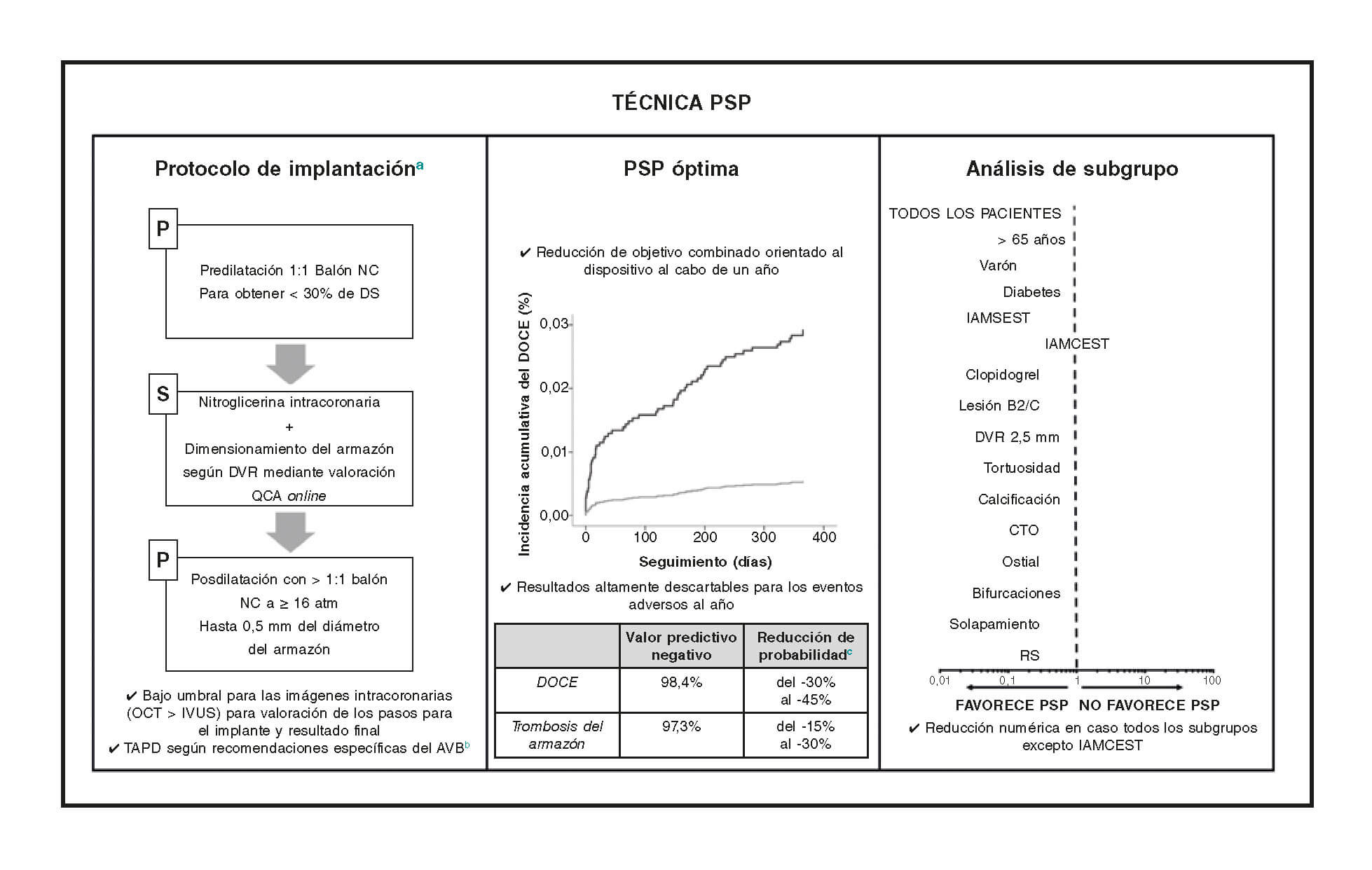
ABSTRACT
Introduction and objectives: The PSP (pre-dilation, sizing and post-dilation) score, derived from the GHOST-EU registry, has evaluated the relationship between the implantation technique of bioresorbable scaffolds and the clinical outcomes. The objective was to perform an external validation of the PSP technique and to determine its effect on adverse cardiac events in various clinical and anatomical scenarios.
Methods: Data from the REPARA registry (2230 patients) were used for external validation, whereas a common database combining REPARA and GHOST-EU (3250 patients) data was used to evaluate the effect of PSP technique in various clinical and anatomical scenarios. PSP-1 and PSP-3 were used to score the appropriateness of pre-dilation, scaffold sizing, and post-dilation. The primary endpoint was 1-year device-oriented composite endpoint of cardiac death, target-vessel myocardial infarction, and target-lesion revascularization. The definite/probable scaffold thrombosis according to the Academic Research Consortium criteria was also evaluated.
Results: A total of 303 (18.2%) patients were treated with an optimal PSP-1, and 182 (8.2%) with an optimal PSP-3. The external validation showed that PSP has a very high negative predictive value for device-oriented composite endpoint and scaffold thrombosis (91.8% and 89.1% for PSP-1; 98.4% and 97.3% for PSP-3, respectively). Patients with an optimal PSP-3 had a numerically lower rate of device-oriented composite endpoint and scaffold thrombosis compared to those without it (0.5% vs 2.9%; P = .085 and 0.5% vs 1.8%; P = .248, respectively). In the merged database, PSP benefits were seen on many scenarios, except in the ST-segment elevation myocardial infarction where a trend towards no benefit of an optimal PSP technique was present (Pinteraction = .100).
Conclusions: In the REPARA registry, at 1-year follow-up, an optimal PSP technique was not associated with a lower rate of device-oriented composite endpoint. Further research is necessary to assess the impact of the PSP technique in longer follow-ups.
Keywords: Coronary artery disease. Percutaneous coronary intervention. Bioresorbable scaffolds. Bioresorbable vascular scaffolds.
RESUMEN
Introducción y objetivos: La escala de puntuación PSP (pre-dilation, sizing and post-dilation), derivada del registro GHOST-EU, evalúa la relación entre la técnica de implante de los armazones bioabsorbibles y los resultados clínicos. El objetivo fue realizar una validación externa de la escala PSP y determinar su efecto en eventos cardiacos adversos en diversos escenarios clínicos y anatómicos.
Métodos: Para la validación externa se emplearon los datos del registro REPARA (2.230 pacientes), mientras que se utilizó una base de datos común que combina datos de REPARA y GHOST-EU (3.250 pacientes) para evaluar el efecto de la técnica PSP en varios escenarios clínicos y anatómicos. Se usó PSP-1 y PSP-3 para calificar la calidad de la predilatación, el dimensionamiento de los armazones y la posdilatación. El objetivo primario fue la variable compuesta orientada al dispositivo (muerte cardiaca, infarto de miocardio del vaso diana y revascularización de la lesión diana) a 1 año. También se evaluó la trombosis definitiva o probable del armazón según los criterios del Academic Research Consortium.
Resultados: Se trató a 303 (18,2%) pacientes con una PSP-1 óptima y a 182 (8,2%) con una PSP-3 óptima. La validación externa mostró que la escala PSP tiene un valor predictivo negativo muy alto para el objetivo primario compuesto orientado al dispositivo y la trombosis del armazón (91,8 y 89,1% para PSP-1; 98,4 y 97,3% para PSP-3, respectivamente). En pacientes con PSP-3 óptimo, el objetivo primario compuesto orientado al dispositivo y la trombosis del armazón fueron numéricamente inferiores en comparación con los pacientes sin PSP-3 óptimo (0,5 frente a 2,9%; p = 0,085; y 0,5 frente a 1,8%; p = 0,248, respectivamente). En la base de datos combinada, los beneficios de la escala PSP se observaron en diversos escenarios, excepto en el de infarto de miocardio con elevación del segmento ST, en el que se observó una tendencia hacia la ausencia de beneficios de una técnica de PSP óptima (pinteracción = 0,100).
Conclusiones: Una técnica de PSP óptima no se asoció con una tasa más baja del objetivo primario compuesto orientado al dispositivo. Se necesitan nuevos estudios para evaluar el impacto de la técnica de PSP con un seguimiento más prolongado.
Palabras clave: Enfermedad coronaria. Intervencion coronaria percutanea. Armazon bioabsorbible. Armazon vascular bioabsorbible.
Abreviaturas: BVS: bioresorbable vascular scaffolds. DOCE: device-oriented composite endpoint. PSP: pre-dilation, sizing and post-dilation. STEMI: ST-segment elevation myocardial infarction.
INTRODUCTION
Recent meta-analyses of randomized clinical trials have rised concerns about the safety of first-generation bioresorbable vascular scaffolds (BVS).1 Specifically, a higher than expected scaffold thrombosis rate compared to drug-eluting stents was found.1-4
Optimization of the implantation technique was proposed to improve clinical outcomes of patients treated with BVS.5,6 The PSP (pre-dilation, sizing and post-dilation) score is a simple model designed to assess the quality of the BVS implantation technique, evaluate the preparation of the lesion, the size of the scaffold, and post-dilation. This score has been developed and internally validated in the GHOST-EU registry and is associated with the occurrence of adverse cardiac events at 1-year follow-up.7 However, this score has not been externally validated, and no data are available on whether the effect of the PSP implantation technique is different in various clinical and anatomical scenarios.
Therefore, we tried to perform an external validation of the PSP technique and evaluate its effect on the adverse cardiac events of patients treated with BVS in various clinical and anatomical scenarios.
METHODS
Population
The REPARA registry is an investigator-initiated, prospective, multicenter registry conducted at 58 Spanish and Portuguese centers. The registry included consecutive patients who underwent single or multivessel percutaneous cardiac intervention with at least one everolimus-eluting BVS device (Absorb BVS; Abbott Vascular, Santa Clara, CA, United States). Patients who underwent percutaneous cardiac intervention for one or two new native coronary artery lesions –up to four lesions– in separate epicardial coronary vessels were eligible for enrollment. Patients with acute myocardial infarction and specific complex lesion features were also included. Data from the REPARA registry were used for external validation of the PSP score. This is a retrospective not pre-specified analysis.
Data from REPARA and GHOST-EU registries were pooled in a single database by one investigator (L. Ortega-Paz) and used to evaluate the effect of the PSP technique in various clinical and anatomical scenarios. Details of the GHOST-EU registry have been described above.7
Procedures and follow-up
All interventions were performed according to the actual guidelines on the management of percutaneous cardiac intervention. Briefly, balloon pre-dilation was not mandatory but highly recommended. Scaffold implantation at pressures not exceeding the burst pressure rate was mandatory. Use of post-dilation was left at operator discretion and, if performed, one non-compliant balloon was recommended according to the protocol. Quantitative coronary angiography analysis pre-BVS implantation was analyzed in a centralized CORE Lab, and only patients with complete quantitative coronary angiography data were included in this analysis.
The PSP evaluation of the BVS implantation technique was applied according to the models previously detailed.7 Overall, 3 steps of scaffold implantation were evaluated in the PSP models shown on table 1. The PSP-2 model was not assessed because the quantitative coronary angiography after pre-dilation was not available.
Table 1. PSP models for the evaluation of implantation
| Implantation steps | PSP-1 | PSP-2 | PSP-3 |
|---|---|---|---|
| Pre-dilation | - Not performed - Performed |
- Either not performed or performed with a QCA residual stenosis ≥ 30% - Performed with a QCA residual stenosis < 30% |
- Not performed - Performed |
| Scaffold sizing | Correct sizing, defined as the following: - implantation of a 2.5 mm diameter scaffold in a vessel with a proximal/distal RVD ≥ 2.5 mm and < 2.75 mm - implantation of a 3.0 mm diameter scaffold in a vessel with a proximal/distal RVD ≥ 2.75 mm and < 3.25 mm; or - implantation of a 3.5 mm diameter scaffold in a vessel with a proximal/distal RVD ≥ 3.25 mm and ≤ 3.75 mm - if proximal and distal RVD differed, the mean value was used Incorrect sizing |
||
| Post-dilation | - Either not performed or performed with a compliant or non-compliant balloon with diameter 0.5 mm greater than the scaffold diameter or performed with a NC balloon with a diameter less than or equal to the scaffold diameter - Performed with an NC balloon of larger diameter than the scaffold, up to a maximum of 0.5 mm |
- Either not performed or performed with a compliant or non-compliant balloon with diameter 0.5 mm greater than the scaffold diameter or performed with a NC balloon with a diameter less than or equal to the scaffold diameter at a pressure < 16 atmospheres. - Performed with a NC balloon of larger diameter than the scaffold, up to a maximum of 0.5 mm and at a pressure ≥ 16 atmospheres. |
|
|
BVS, bioresorbable vascular scaffolds; NC, non-compliant; PSP, pre-dilation, sizing and post-dilation; QCA, quantitative coronary angiography; RVD, reference vessel diameter. |
|||
Clinical follow-up was obtained through clinical visits or phone calls at 12-month in both registries. In the REPARA registry, the process of data mining was externally monitored, and events were adjudicated by an independent committee. The occurrence of periprocedural myocardial infarction was not systematically assessed.
Outcomes and definitions
The primary endpoint was device-oriented composite endpoint (DOCE) of cardiac death, target-vessel myocardial infarction, and clinically driven target lesion revascularization (CD-TLR). Secondary outcomes were the individual components of the primary endpoint and definite/probable scaffold thrombosis, defined according to the Academic Research Consortium (ARC) criteria.8 REPARA and GHOST-EU registries used the same endpoints definitions according to the ARC criteria.8 Optimal PSP technique was defined as the highest PSP score value.7 In patient with more than one lesion treated, all the lesions should fulfill the optimal PSP criteria; otherwise the patient was classified as non-optimal. All endpoints were analyzed at 1-year follow-up.
Statistical analysis
Continuous variables are presented as the mean ± standard deviation or median and interquartile range, as appropriate. Categorical variables are reported as absolute number and percentage. Differences in proportions were tested with chi-square or Fisher exact test and differences in continuous variables were tested with Student t-test.
External validation of the PSP score was performed according to TRIPOD type 4 validation.9 The PSP scores were evaluated in terms of overall performance, calibration, and discrimination, as previously shown.10 The overall performance of the models was assessed by Nagelkerke’s R2.10 Calibration was measured by the Hosmer-Lemeshow test.10 Discrimination was measured with the area under the receiver-operator characteristic curves (AUCs).10 Predictive values and likelihood ratios were also calculated.10 In the external validation population of the REPARA registry, weight of PSP technique and each component was evaluated by a Cox regression, adjusting for those variables predictors of DOCE at univariate analysis: diabetes, prior myocardial infarction or revascularization, multivessel disease, severely calcified lesion, bifurcations, and scaffold overlapping.
In the pooled database (REPARA and GHOST-EU data), the effect of the PSP technique on the DOCE was evaluated with formal interaction testing in various clinical and anatomical scenarios. These analyses were performed only for the model that performed the best.
A Kaplan-Meier method was used to derive the event rates at follow-up and to plot time-to-event curves, dividing the population according to the optimal PSP technique or each implantation step score. The Kaplan-Meier curves were compared using the log-rank test.
A 2-tailed P-value < .05 was considered significant. All data were processed using the Statistical Package for Social Sciences, version 22 (SPSS Inc., Chicago, IL, United States).
RESULTS
External validation population
A total of 2448 patients (3370 lesions) were included in the REPARA registry. Due to missing data for the evaluation of the PSP-1 and PSP-3 scores, only 2230 patients (2553 lesions) were included in this analysis (figure 1 of the supplementary data). The PSP-2 score was not evaluable due to missing residual percentage stenosis after pre-dilation in all patients, and therefore not considered for this analysis. There were no differences between patients included and those excluded in terms of clinical outcomes (data not shown).
Figure 1. PSP score models performance. A: Rule-in performance: PSP-1: R2: 0.02, HL: X2=2.04 (0.727), and AUCs: 0.587 (0.511-0.664); P = .020. PSP- 3: R2: 0.03, HL: X2=1.84 (0.606), and AUCs: 0.603 (0.528-0.677); P = .006. B: Rule-out performance. 95%CI, 95% confidence interval; UCs, area under the receiver-operator characteristic curve (95%CI); DOCE, device-oriented composite endpoint; HL, Hosmer-Lemeshow (P-value); R2, Nagelkerke’s R2.
Patients treated with an optimal PSP-1 and PSP-3 techniques were 303 (13.6%), and 182 (8.2%), respectively (table 2; figure 2 of the supplementary data). The clinical and procedural data according to the optimal PSP score are shown on table 1 of the supplementary data, table 2 of the supplementary data, table 3 of the supplementary data, and table 4 of the supplementary data.
Table 2. Distribution of PSP models
| PSP-1 (n = 2553)a | PSP-3 (n = 2553)a | |
|---|---|---|
| Optimal PSP technique (%) | 357 (14.0) | 219 (8.6) |
| 1:1 pre-dilation, n (%) | ||
| No | 497 (19.5) | 497 (19.5) |
| Yes | 2056 (80.5) | 2056 (80.5) |
| Scaffold sizing, n (%) | ||
| Incorrect | 507 (19.9) | 507 (19.9) |
| 2.50 mm | 135 (26.6) | 135 (26.6) |
| 3.00 mm | 193 (38.1) | 193 (38.1) |
| 3.5 mm | 179 (35.3) | 179 (35.3) |
| Correctb | 2046 (80.1) | 2046 (80.1) |
| Post-dilation, n (%) | ||
| No | 1313 (51.4) | 1313 (51.4) |
| Over-expandedb | 39 (1.5) | 39 (1.5) |
| NC balloon > 1:1b | 623 (24.4) | NA |
| NC balloon > 1:1 and pressure ≥ 16 atm | NA | 393 (15.4) |
| QCA analysis pre-BVS implantation | ||
| RVD proximal (mm) | 3.10 ± 0.42 | 3.10 ± 0.42 |
| RVD distal (mm) | 2.92 ± 0.55 | 2.92 ± 0.55 |
| Mean RVD (mm) | 3.02 ± 0.51 | 3.02 ± 0.51 |
| Lesion length (mm) | 18.15 ± 9.32 | 18.15 ± 9.32 |
| Stenosis (%) | 84.10 ± 13.1 | 84.10 ± 13.1 |
| MLD (mm) | 0.98 ± 1.15 | 0.98 ± 1.15 |
|
Lesion-level analysis. aDefined as in the development and internal validation.7 bATM, atmospheres; MLD, minimal lumen diameter; NA, not applicable; NC, non-compliant; PSP, pre-dilation, sizing and post-dilation; QCA, quantitative coronary angiography; RVD, reference vessel diameter. |
||
Figure 2. PSP technique: Kaplan-Meier analysis. Panel A: PSP-1: acute events (< 24h): 0% (0/303) vs 0.3% (6/1927), log-rank P = .331. Sub-acute events (1-30 d) 0.3% (1/303) vs 0.9% (18/1921), log-rank P = .286. Late events (30-235 d) 1.3% (4/302) vs 1.7% (32/1903), log-rank P = .650. Panel B: PSP-3: Acute events (<24h): 0% (0/182) vs 0.3% (6/2048), log-rank P = .465. Sub-acute events (1-30 days) 0% (0/182) vs 0.9% (19/2042), log-rank P = .192. Late events (30-365 days) 0.5% (1/182) vs 1.8% (36/2023), log-rank P = .230. Panel C: pre-dilation: HR, 1.07; 95%CI, 0.58-2.00; P = .824. Scaffold sizing: HR, 0.43; 95%CI, 0.25-0.75; PP = .003. Post-dilation: HR, 0.66; 95%CI, 0.34-1.26; P = .208. Panel D: pre-dilation: HR, 1.10; 95%CI, 0.59-2.05; P = .766. Scaffold sizing: HR, 0.42; 95%CI, 0.24-0.72; P = .002. Post-dilation: HR, 0.33; 95%CI, 0.12-0.92, P = .035. At a patient-level analysis, DOCE includes TV-MI, and target lesion revascularization. 95%CI, 95% confidence interval; DOCE, device-oriented composite endpoint; HR, hazard ratio; PSP, pre-dilation, sizing and post-dilation; TV-MI, target vessel myocardial infarction.
Table 3. Clinical outcomes at 1-year follow-up stratified according to the optimal PSP technique
| PSP-1 model | ||||
|---|---|---|---|---|
| Optimal PSP (n = 303)a | Non-optimal PSP (n = 1927)a | HR (95%CI) | P | |
| DOCEb | 5 (1.7) | 56 (2.9) | 1.75 (0.69-4.45) | .219 |
| Cardiac death | 1 (0.3) | 14 (0.7) | 2.21 (0.30-16.87) | .444 |
| TV-MI | 3 (1.0) | 31 (1.6) | 1.64 (0.50-5.38) | .419 |
| TLR | 3 (1.0) | 42 (2.2) | 2.23 (0.69-7.23) | .182 |
| Definite/probable scaffold thrombosis | 4 (1.3) | 33 (1.7) | 1.30 (0.46-3.70) | .620 |
| PSP-3 model | ||||
| Optimal PSP (n = 182)a | Non-optimal PSP (n = 2048)a | HR (95%CI) | P | |
| DOCEb | 1 (0.5) | 60 (2.9) | 5.73 (0.78-41.88) | .085 |
| Cardiac death | 0 | 15 (0.7) | NA | .627 |
| TV-MI | 1 (0.5) | 33 (1.6) | 2.96 (0.40-21.80) | .286 |
| TLR | 1 (0.5) | 44 (2.1) | 3.97 (0.54-29.01) | .174 |
| Definite/probable scaffold thrombosis | 1 (0.5) | 36 (1.8) | 3.24 (0.44-23.76) | .248 |
|
aPatient-level analysis. bMultivariate adjusted Cox model. DOCE includes cardiac death, TV-MI, and TLR. 95%CI, 95% confidence interval; DOCE, device-oriented composite endpoint; HR, hazard ratio; NA, not applicable; PSP, pre-dilation, sizing and post-dilation; TLR, target lesion revascularization; TV-MI, target vessel myocardial infarction. |
||||
External validation
The PSP-3 score displayed the best calibration (X 2= 1.84, P = .606 using the Hosmer-Lemeshow statistic test) and the best discrimination (AUC, 0.603; 95% confidence interval [95%CI], 0.528–0.677; P = .006) (figure 1A). Both PSP-1 and PSP-3 scores displayed a high negative predictive value with a low negative likelihood ratio either for DOCE or scaffold thrombosis (figure 1B).
At 1-year follow-up, there was no difference in the rate of DOCE between patients with an optimal PSP-1 technique and those without it (1.6% vs 2.9%; hazard ratio [HR], 1.75; 95%CI, 0.69–4.45]; P = .239, adjusted analysis) (table 3). A trend towards a lower rate of DOCE was found in patients with an optimal PSP-3 technique compared to those without it (0.5% vs 2.9%; HR, 5.73; 95%CI, 0.78–41.88; P = .085, adjusted analysis) (table 3). Figure 2A and figure 2B show the Kaplan-Meier curves for DOCE of the PSP scores.
Within the PSP-1 score, correct scaffold sizing was associated with a reduction in DOCE (HR, 0.43; 95%CI, 0.25–0.75; P = .003). Within the PSP-3 score, either the correct scaffold sizing (HR, 0.42; 95%CI, 0.24–0.72; P = .002) or the correct post-dilation (HR, 0.33; 95%CI, 0.12–0.92; P = .035) were associated with fewer DOCE (figure 2C,D).
At 1-year follow-up, simplified strategies considering only the pre-dilation and post-dilation as defined according to the models PSP-1 (HR, 1.50; 95%CI, 0.70–3.19; P = .294) and PSP-3 (HR, 1.80; 95%CI, 0.65–5.02; P = .260) were not associated with a lower DOCE either.
Effect of an optimal PSP technique on various clinical and anatomical scenarios
In the combined REPARA and GHOST-EU database, patients with the optimal PSP technique have lower rates of DOCE compared to those without it in almost all clinical and angiographic scenarios analyzed. In STEMI patients, there was a trend towards no benefit of an optimal PSP technique (Pinteraction = .100) (figure 3).
Figure 3. Effect of an optimal PSP technique on DOCE in various clinical and anatomical scenarios at 1-year follow-up Pooled analysis of the GHOST-EU and REPARA registries.
a The P-value for interaction represents the likelihood of interaction between the variable and a maximum PSP score.
b Multivariate adjusted model.
c Data were only available from the REPARA registry.
d According to the criteria of the American College of Cardiology-American Heart Association.
e Data were only available from the GHOST-EU registry.
Patient-level analysis.
95%CI, 95% confidence interval; ACS, acute coronary syndrome; CTO, chronic total occlusion; NA, not applicable; PSP, pre-dilation, sizing and post-dilation; RR, risk ratio; RVD, reference vessel diameter; STEMI, ST-segment elevation myocardial infarction.
DISCUSSION
The main findings of our study are: a) an optimal PSP technique was not associated with a lower rate of DOCE; b) a correct scaffold sizing and post-dilation were associated with fewer DOCE; c) the effect of an optimal PSP technique seems to be less important in the ST-segment elevation myocardial infarction (STEMI) compared to other clinical and anatomical scenarios (figure 4).
Figure 4. Effect of the PSP technique in various clinical and anatomical scenarios. In the routine clinical practice, the PSP score is a simple score model designed to assess the quality of BVS implantation technique by assessing the 3 fundamental steps of the PSP technique. At 1-year follow-up, an optimal PSP technique is related to fewer DOCE and a very high negative predictive value for DOCE and definite/probable scaffold thrombosis. The effect of an optimal PSP technique on STEMI patients seems to be less significant.
aDetailed procedural considerations were reported during the development and internal validation.7
bExpert recommendations on DAPT in patients treated with BVS.4
cThe probability reduction was estimated by means of negative likelihood ratios.13
ATM, atmospheres; BVS, bioresorbable scaffolds; CTO, chronic total occlusion; DAPT, dual antiplatelet therapy; DOCE, device-oriented composite endpoint; DS, diameter stenosis; ISR, in-stent restenosis; IVUS, intravascular ultrasound; NC, non-compliant balloon; OCT, optical coherence tomography; PSP, pre-dilation, sizing and post-dilation; QCA, quantitative coronary angiography; RVD, reference vessel diameter; STEMI, ST-segment elevation myocardial infarction.
Clinical value of the PSP technique in the validation cohort
The PSP technique has been proposed to analyze the quality of the BVS implantation technique with clinical outcomes.7 The present analysis applied the PSP score to the population of the REPARA registry in external validation. An optimal PSP technique was not associated with a lower rate of DOCE. Specifically, an optimal PSP-1 technique was not associated with a lower rate of DOCE, meanwhile there was a trend to a lower rate of DOCE in patients treated with an optimal PSP-3 technique. The low rate of DOCE and the improvement of the technique may be related with this finding. Even though we did not confirm the effect of the PSP score on clinical outcomes, we believe that most of the medical literature suggests that an optimal implantation technique may improve the outcomes. In the analysis of the ABSORB trials, the sizing of the vessel and operator technique were strongly associated with the outcomes at a 3-year follow-up.11 Nevertheless, other authors had found no relationship between the PSP technique and the outcomes when the analysis was done at lesion-level.12
Also, in the derivation cohort or this validation cohort, the rate of patients treated with optimal PSP technique was very low (13.3% and 8.2%, respectively).7 Patients herein treated with an optimal PSP technique exhibited a trend towards a lower rate of DOCE compared to those without it. We should mention here that the PSP technique exhibited a high rule-out performance, with a very high negative predictive value and a low likelihood ratio: this shows that a patient with an optimal PSP technique has a probability of being DOCE-free at 1-year that is close to 100%.10 Likelihood ratios are used for assessing the value of performing a diagnostic test or score model, with a lower value associated with a lower probability of an endpoint. Therefore, the very low negative likelihood ratios found in this analysis means that an optimal PSP technique was associated with a large to moderate reduction in DOCE occurrences (-30% to -45%).13
Within the individual steps of the PSP technique, the correct scaffold sizing was performed in a higher percentage of patients in this validation cohort compared to the derivation cohort (80% versus 50%, respectively). This improvement could be related to the publication of the ABSORB III trial in between the GHOST-EU and REPARA registries, which showed a higher incidence of events in small vessels.14 The importance of the correct sizing of the vessels for BVS implantation was further highlighted in our analysis, together with correct post-dilation (figure 2).
Effect of an optimal PSP technique in various clinical and anatomical scenarios
Current data support the use of the pre-specified implantation technique for BVS implantation, but it is unknown if this should be applied to all patients or lesions or if some subgroup may benefit most from it.5,7 Whereas calcified lesions may, for example, require a perfect PSP technique for BVS outcome optimization, soft lesions may not. For this reason, in the pooled database, we explored the effect of an optimal PSP technique on DOCE in different clinical and anatomical scenarios. Interestingly, we found that in all situations, the analyzed patients treated with an optimal PSP technique have a lower rate of DOCE compared with patients without it. However, in STEMI patients, there was a trend towards no benefit of an optimal PSP technique. This could be related to the specific characteristic of the STEMI lesions, which are usually soft and thrombotic with less need for lesion preparation or post-dilation in order to reduce distal embolization.15 In patients with abundant thrombotic material or coronary vasoconstriction, the vessel diameter can be underestimated; use of manual thrombus aspiration and intracoronary nitroglycerin could be useful in these situations, thus allowing the implantation of bigger and shorter stents.16 A former study suggested, for example, that in STEMI patients a slight scaffold oversizing could help achieve better acute outcomes.17 It should also be noted here that the percentage of STEMI patients was lower in the derivation than in the validation cohort (15% vs 26%, respectively): this difference could have affected the performance of the score in this specific situation. This finding is supported by the results of the BVS STEMI STRATEGY-IT Study, in which a pre-specified Absorb BVS implantation strategy in STEMI was evaluated. In this study, a low rate of DOCE was observed during the short and mid-term follow-up.18 Furthermore, in a sub study of the STRATEGY-IT, we found that an optimal PSP technique was not associated with improved outcomes. Interestingly, thrombectomy before optimal BVS implantation showed a trend towards higher post minimal lumen diameter and lower scaffold footprint.19
Even though the Absorb BVS is no longer available in the clinical practice, there are several BVS ongoing clinical and preclinical evaluation. In these new devices the effect of the implantation technique is unknown, but due to the similarities of these technologies, it seems probable that the implantation technique should also have an effect on the clinical outcomes.
Limitations
This study has limitations that should be acknowledged. First, due to the low rate of events and optimal PSP technique, the clinical relevance of the predictive values may be limited. Secondly, the subgroup analyses are statistically underpowered and should be considered hypothesis-generating only. Thirdly, longer-term follow-up is needed to validate the PSP score models beyond 1-year of follow-up. Despite these limitations, this analysis also has important strengths such as being a large multicenter registry with broad inclusion criteria and few exclusion criteria. The REPARA registry, in particular, facilitated a complete temporal and geogra- phical validation of the score, which reinforces the methodology of this analysis.
CONCLUSIONS
In the REPARA, at 1-year follow-up, an optimal PSP technique was not associated with a lower rate of device-oriented composite endpoint. An optimal PSP technique has a very high negative predictive value for BVS DOCE and scaffold thrombosis. It should be noted that, in STEMI patients, there was a trend towards no benefit from using the optimal PSP technique. Studies with longer follow-up are needed to assess the effect of the optimal PSP technique on very-late events and in specific STEMI settings.
FUNDING
The REPARA registry was funded by the Spanish Society of Cardiology.
CONFLICTS OF INTEREST
R. Moreno and J. Sanchis are Associate Editors of REC: Interventional Cardiology.
WHAT IS KNOWN ABOUT THE TOPIC?
- The PSP score has been proposed to assess the quality of bioresorbable scaffolds implantation technique.
- The optimization of BVS implantation can be related to a reduction in adverse events.
WHAT DOES THIS STUDY ADD?
- In patients treated with an optimal PSP technique, there was a reduction of adverse cardiac events. A maximum PSP score was related to a very high negative predictive value of DOCE and scaffold thrombosis.
- The effect of PSP in STEMI seems less important compared to other clinical and anatomical scenarios.
- Future trials with longer follow-up are needed to assess the effect of an optimal PSP technique beyond 1-year follow-up.
- The effect of an optimal PSP technique among different clinical and anatomical scenarios should be confirmed.
- In STEMI patients, further research is necessary to develop and validate a specific implantation protocol.
REFERENCES
1. Ali ZA, Serruys PW, Kimura T, et al. 2-year outcomes with the Absorb bioresorbable scaffold for treatment of coronary artery disease:a systematic review and meta-analysis of seven randomised trials with an individual patient data substudy. Lancet. 2017. 2017;390:760-772.
2. Serruys PW, Chevalier B, Sotomi Y, et al. Comparison of an everolimus-eluting bioresorbable scaffold with an everolimus-eluting metallic stent for the treatment of coronary artery stenosis (ABSORB II):a 3 year, randomised, controlled, single-blind, multicentre clinical trial. Lancet. 2016;388:2479-2491.
3. Wykrzykowska JJ, Kraak RP, Hofma SH, et al. Bioresorbable Scaffolds versus Metallic Stents in Routine PCI. N Engl J Med. 2017;376:2319-2328.
4. Capodanno D, Angiolillo DJ. Antiplatelet Therapy After Implantation of Bioresorbable Vascular Scaffolds:A Review of the Published Data, Practical Recommendations, and Future Directions. JACC Cardiovasc Interv. 2017;10:425-437.
5. Puricel S, Cuculi F, Weissner M, et al. Bioresorbable Coronary Scaffold Thrombosis:Multicenter Comprehensive Analysis of Clinical Presentation, Mechanisms, and Predictors. J Am Coll Cardiol. 2016;67:921-931.
6. Tamburino C, Latib A, van Geuns RJ, et al. Contemporary practice and technical aspects in coronary intervention with bioresorbable scaffolds:a European perspective. EuroIntervention. 2015;11:45-52.
7. Ortega-Paz L, Capodanno D, Gori T, et al. Predilation, sizing and postdilation scoring in patients undergoing everolimus-eluting bioresorbable scaffold implantation for prediction of cardiac adverse events:development and internal validation of the PSP score. EuroIntervention. 2017;12:2110-2117.
8. Cutlip DE, Windecker S, Mehran R, et al. Clinical end points in coronary stent trials:a case for standardized definitions. Circulation. 2007;115:2344-2351.
9. Collins GS, Reitsma JB, Altman DG, and Moons KG. Transparent Reporting of a multivariable prediction model for Individual Prognosis or Diagnosis (TRIPOD):the TRIPOD statement. Ann Inter Med. 2015;162:55-63.
10. Steyerberg EW, Vickers AJ, Cook NR, et al. Assessing the performance of prediction models:a framework for traditional and novel measures. Epidemiology. 2010;21:128-138.
11. Stone GW, Abizaid A, Onuma Y, et al. Effect of Technique on Outcomes Following Bioresorbable Vascular Scaffold Implantation:Analysis From the ABSORB Trials. J Am Coll Cardiol. 2017;70:2863-2874.
12. Tijssen RYG, Kraak RP, Elias J, et al. Implantation techniques (predilatation, sizing, and post-dilatation) and the incidence of scaffold thrombosis and revascularisation in lesions treated with an everolimus-eluting bioresorbable vascular scaffold:insights from the AIDA trial. EuroIntervention. 2018;14:e434-e442.
13. McGee S. Simplifying likelihood ratios. J Gen Intern Med. 2002;17:646-649.
14. Steinvil A, Rogers T, Torguson R, and Waksman R. Overview of the 2016 U.S. Food and Drug Administration Circulatory System Devices Advisory Panel Meeting on the Absorb Bioresorbable Vascular Scaffold System. JACC Cardiovasc Interv. 2016;9:1757-1764.
15. Zhang ZJ, Marroquin OC, Stone RA, et al. Differential effects of post-dilation after stent deployment in patients presenting with and without acute myocardial infarction. Am Heart J. 2010;160:979-986 e1.
16. Fernandez-Rodriguez D, Regueiro A, Brugaletta S, et al. Optimization in stent implantation by manual thrombus aspiration in ST-segment-elevation myocardial infarction:findings from the EXAMINATION trial. Circ Cardiovasc Interv. 2014;7:294-300.
17. Kocka V, Maly M, Tousek P, et al. Bioresorbable vascular scaffolds in acute ST-segment elevation myocardial infarction:a prospective multicentre study 'Prague 19'. Eur Heart J. 2014;35:787-794.
18. Ielasi A, Campo G, Rapetto C, et al. A Prospective Evaluation of a Pre-Specified Absorb BVS Implantation Strategy in ST-Segment Elevation Myocardial Infarction:The BVS STEMI STRATEGY-IT Study. JACC Cardiovasc Interv. 2017;10:1855-1864.
19. Hioki H, Brugaletta S, Ishida K, et al. Impact of Absorb bioresorbable scaffold implantation technique on post-procedural quantitative coronary angiographic endpoints in ST-elevation myocardial infarction:a sub-analysis of the BVS STEMI STRATEGY-IT study. EuroIntervention. 2018. http://dx.doi.org/10.4244/EIJ-D-18-00504.
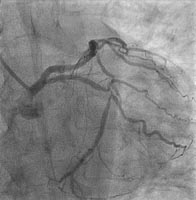
Abstract
Introduction and objectives: Accessing sharply angulated side branches using intracoronary guidewires sometimes poses great challenges, and even after using its distal end for accessing purposes, it usually prolapses inside the main vessel. We hereby present an easy way to perform these procedures using a specific guidewire for the management of chronic total occlusions.
Methods: From January 2017 through September 2018, patients with lesions on sharply angulated side or large branches that required protection in bifurcations were approached using straight, angled tip and/or double-lumen microcatheters with regular guidewires. In cases of unsuccessful access, a specific wire designed for chronic total occlusions was used with the straight tip microcatheter after a drastic overhaul of the shape in its distal end.
Results: In 9 patients access to the side branch was not achieved with the initial strategy, in 3 patients due to access inability and in the remaining 6 due to guidewire prolapse when trying to advance the microcatheter. In all 9 cases, the access could be completed using the Gaia First guidewire that combines an excellent torque with enough rigidity to prevent the prolapse of the tip. All procedures were performed without complications.
Conclusions: The percutaneous coronary intervention of sharply angulated side branches can be challenging when advancing the guidewire. However, these procedures can be performed easily and quickly with a specific guidewire for the managemenf of chronic total occlusions.
Keywords: Bifurcation. Coronary guidewire. Angulated lesion. Chronic total occlusion.
Resumen
Introducción y objetivos: El acceso con la guía intracoronaria a las ramas laterales con origen muy angulado en ocasiones presenta gran dificultad, e incluso después de acceder con el extremo distal frecuentemente se produce su prolapso en el vaso principal. Presentamos una forma fácil de realizar estos procedimientos con el uso de una guía específica de oclusión crónica.
Métodos: Entre enero de 2017 y septiembre de 2018, los pacientes con lesiones en las ramas laterales o en ramas de gran tamaño que requerían protección en las bifurcaciones cuyo origen era muy angulado se abordaron con microcatéteres recto, angulado o de doble luz con guías regulares; posteriormente, en caso de imposibilidad de acceso, se pasó una guía específica de oclusión crónica con el microcatéter recto tras una modificación muy marcada de la forma del extremo distal de la guía.
Resultados: En nueve pacientes no se consiguió el acceso a la rama lateral con la estrategia inicial, en tres de ellos por imposibilidad de acceso y en los seis restantes por prolapso de la guía al intentar progresar el microcatéter. En todos los casos el acceso pudo completarse con una guía Gaia First, que combina un excelente torque con una rigidez suficiente para evitar el prolapso. Todos los procedimientos se realizaron sin complicaciones.
Conclusiones: El intervencionismo percutáneo en las ramas laterales con una marcada angulación puede conllevar una gran dificultad para el acceso con la guía. Estos procedimientos pueden realizarse de forma fácil y rápida con una guía específica de oclusión crónica.
Palabras clave: Bifurcación. Guía intracoronaria. Lesión angulada. Oclusión crónica.
Introduction
At times, using intracoronary guides to access sharply angulated lateral branches with a lesion that requires protection when treating bifurcations is extremely difficult. There is not too much information in the medical literature on the number of branches that cannot be accessed, but experienced groups say that the rate is around 3%1. Accessing the lateral branch is usually easy when the angle between the main branch and the lateral branch is < 70°, more difficult with distal bifurcation angles > 70º, and especially difficult with angles > 90°.
Different techniques and devices have been designed such as angulated microcatheters, double-lumen catheters2 or deflectable catheters2 o defectables3,4, which, combined with the use of hydrophilic guidewires allow us to be able to perform procedures. However, even when access has not occurred, the prolapse of the guidewire towards the main branch is a common thing when advancing the guidewire or the microcatheter, especially when dealing with sharp angles and large caliber main branches.
We hereby present a way to conduct this kind of procedure using a specific chronic occlusion guidewire that combines excellent maneuverability with great support in its distal edge to avoid prolapse. Additionally, we will be reviewing the different techniques and devices available today to perform these procedures.
Methods
Between January 2017 and October 2018, we analyzed patients with an indication for percutaneous intervention in their lateral branches or branches requiring a second guidewire when treating a bifurcation whose origin had a ≥ 80° angle through visual assessment. In all cases, the initial strategy was to use one Caravel microcatheter (Asahi, Japan) with the Sion and Fielder XT guidewires followed by the Stride angulated microcatheter (Teleflex, United States) or the Crusade double-lumen microcatheter (Kaneka, Japan).
In those cases where the guidewire advanced successfully with such devices, the Gaia First guidewire (Asahi, Japan) with the Caravel microcatheter was used. This guidewire was picked because of its excellent maneuverability, capacity to maintain the shape of its distal edge and the support granted by its distal segment. The characteristics of the procedures conducted with the Gaia First guidewire as well as the properties of this guide are described here because, in our opinion, they can be of great help in these cases.
Results
During the entire period of the study, 1342 percutaneous coronary interventions (PCIs) were conducted at our center, and in 52 (3.8%) of them, the lesion was found in a lateral branch whose origin had a ≥ 80° angle or was a bifurcation with an oversized lateral branch and the mentioned exit angle. In nine patients we were not able to access the lateral branch using the Sion or the Fielder XT guidewires and straight, angulated, or double-lumen microcatheters; in three cases it was due to the fact that we could not access using the guidewire distal edge, and in the remaining six because the main vessel prolapsed when trying to advance the guidewire or the microcatheter. All procedures were conducted using 6-Fr catheters, eight of them using the radial approach and the remaining one using the femoral approach. Table 1 shows the characteristics of the different cases.
Table 1. Characteristics of patients and lesions
| Age (years) | Bifurcation | Location | Indication of guidewire in lateral branch | Previous microcatheter | Angle | |
|---|---|---|---|---|---|---|
| Case 1 | 58 | LAD-diagonal | Diagonal | Protection | Angulated + double lumen | 80º |
| Case 2 | 53 | CX-OM1 | OM1 | Percutaneous interventionism | Angulated | 80º |
| Case 3 | 71 | CX-OM1 | OM1 | Protection | Angulated + double lumen | 100º |
| Case 4 | 80 | LAD-diagonal | Diagonal | Protection | Angulated | 100º |
| Case 5 | 60 | LAD-diagonal | Diagonal | Percutaneous interventionism | Angulated + double lumen | 100º |
| Case 6 | 53 | CX-OM1 | OM1 | Protection | Double lumen | 90º |
| Case 7 | 64 | LAD-diagonal | Diagonal | Protection | Angulated | 100º |
| Case 8 | 55 | LAD-diagonal | Diagonal | Percutaneous interventionism | Angulated + double lumen | 100º |
| Case 9 | 76 | Trunk-CX | CX | Percutaneous interventionism | Angulated | 120º |
|
CX, circumflex artery; LAD, left anterior descending artery; OM1, obtuse marginal. |
||||||
The last step that was successful in all the patients consisted of using the Caravel straight microcatheter and the Gaia First guidewire after modifying the shape of the tip to make it match the angle of the vessel (figure 1). Thanks to its excellent maneuverability and the support granted by its distal edge, this guidewire allows easy access to the vessel and facilitates the advance of the microcatheter so that we can change this guide by another guidewire with a softer tip. No coronary dissections, or vessel occlusions were reported, and all procedures were completed with optimal results.
Figure 1. Modification of the Gaia First guidewire tip.
Video 1 of the supplementary data shows a case with a sharply angulated origin in a dominant circumflex artery of a very high-risk patient with a 25% ejection fraction who suffered from an anterior infarction back in 2002. The left anterior descending artery had a chronic occlusion of 50 mm in length with a scab in its anterior side. The procedure was conducted using the Impella CP ventricular assist device (Abiomed, United States) and the circumflex artery was accessed using the Gaia First guidewire and the aforementioned technique after trying the Sion and Fielder XT guidewires and one angulated microcatheter. Two 2 × 15 mm Resolute Onix stents (Medtronic, United States) were implanted at the beginning of the circumflex artery with optimal angiographic results (video 2 of the supplementary data). The patient was discharged three days after the uneventful implantation of a triple chamber defibrillator.
Figure 2 and figure 3 show two cases with double angulation with unsuccessful access using conventional guidewires; and figure 4 and figure 5, show two cases where the problem was the prolapse of the tip of the guidewire when trying to advance the guidewire or the microcatheter.
Figure 2. Access to the distal anterior descending artery, with a severe lesion, double angulation and diagonal bifurcation in the middle segment. Filed access with conventional guidewires and microcatheters.
Figure 3. Access to the distal circumflex artery with double bifurcation and double angulation in the middle segment. Failed access with conventional guidewires and microcatheters.
Figure 4. Access to the second marginal obtuse artery with double angulation. It was accessed using a conventional guidewire but repeated prolapse occurred when trying to advance the guidewire.
Figure 5. Access to the diagonal with angulated origin. It was accessed using a conventional guidewire but repeated prolapse occurred when trying to advance the guidewire.
Discussion
Accessing sharply angulated lateral branches with intracoronary guidewires can be difficult. To be able to solve this problem, several options5, have been described, among these, shaping the curvature of the tip of the guidewire, using guidewires with hydrophilic or more rigid polymeric coating, the double guidewire technique, inflating the balloon inside the main branch to modify the access, and use microcatheters with different designs (angulated, double-lumen, or deflectable).
The tip of the guidewire should have an adequate shape to facilitate access to the lateral branch. The curves typically used to access bifurcations are basically four: one single curve with a short tip (2-3 mm), one single curve with a long tip (4-6 mm), one single curve without rough angulation, and a double curve6. The latter are the most suitable shapes in cases of sharp angulations.
This study details the use of a guidewire designed for chronic occlusions7 and facilitate access to sharply angulated branches. The Gaia First guidewire, same as it happens with the Gaia Second and Third guidewires was first introduced into the market back in 2014. Seventeen years after its manufacturer, Asahi, would develop the very first prototype of specific guidewires for the management of chronic occlusions, the Miracle guidewire. Its design includes the 400 mm long SLIP-COAT coating that improves maneuverability inside the microcatheter with a distal coil structure of 150 mm, a 0.010” diameter and a load of 1.7 g on the tip. Such a design enables an excellent 1:1 capacity of manipulation which, in turn, helps maneuver the guidewire under optimal conditions. Although it was designed for the management of chronic occlusions, its perfect maneuverability of the tip added to how rigid the 150 mm distal segment is, and its capacity to maintain the shape of the tip make it an excellent guidewire for the access of sharply angulated branches granting the right support for the advancement of the microcatheter. We think it is important to say that this strategy used as a fist choice strategy after the hydrophilic guidewire has failed added to a straight microcatheter, can be very attractive financially since we do not need to use any additional curved, double-lumen, or deflectable microcatheters. However, we should not forget that although no complications were reported in the series described, the number of cases is limited and we always have to bear in mind that, even though it is a guidewire of limited lightweight and excellent maneuverability, it was designed for the management of chronic occlusions, so it should be used with care due to the theoretical risk of dissection or occlusion of the blood vessel.
There are other guidewires specifically designed for this type of lesions such as the Sion Black (Asahi, Japan), but, since this guidewire was not used in the lesions presented in this series, we cannot give any information on how it may behave in cases like the one presented here. Also, it is very difficult to have access to all the guidewires available in the market today and the goal of this study was to give an alternative solution when the first intention guidewires fail.
Another technique is the retrograde access to the lateral branch by giving the lateral branch guidewire much more curvature and trying to access the branch when the guidewire has been removed8. This is a sophisticated technique when using doublelumen microcatheters since we insert one hydrophilic guidewire whose very curved distal edge stands out through the lateral orifice of the microcatheter2,9-12. The idea is almost the same, to advance the double-lumen catheter over the guidewire located in the monorail compartment while the guidewire tries to access the lateral branch located in the coaxial compartment and standing out 5 mm to 10 mm through the lateral orifice and with the curve oriented almost 180º with respect to the main vessel. This way, when removing the microcatheter, we should be able to access the lateral branch using the bent guidewire.
We can also use the Venture deflectable catheter (Teleflex, United States) -compatible with e 6-Fr guidewire catheter- available in coaxial and monorail design, that allows us to use any 0.014” coronary guidewires.4,13. The 8 mm distal tip is radiopaque and it can bend up to 90º rotated with clockwise torque in the catheter proximal area. In order to avoid any traumas, it is advanced towards the lesion over a guidewire in straight position and, once the point of interest has been reached, the tip starts to bend until it reaches the target angle. This deflection capability added to the possibility of turning the tip of the catheter in a circumferential plane, allows us to direct the guidewire and, once it has passed, rotate it in the counterclockwise direction to make the catheter return to its straight position and then be able to remove it.3. The rate of success when accessing lateral branches is said to be close to 80%-85%3,4, and the rigidity of the tip requires being extremely careful to limit the possibility of traumatizing the vessel. A few cases of destructured guidewire due to over-manipulation have been reported.
Finally, it has also been suggested that we should inflate a balloon inside the bifurcation in order to change the plaque and allow access to the branch14, but this solution should only be used when the other solutions have failed because, although it is easy to do, previous dilatations can cause changes in the plaque and eventually lead to occluding the branch15.
Conclusions
Accessing sharply angulated lateral branches is very hard to do with the guidewire, at times, because the access site will not allow it, or due to posterior prolapse towards the main vessel. On top of angulated, double-lumen, or deflectable microcatheters with routine guidewires, these procedures can be performed easily using a specific guidewire for the management of chronic occlusions that combines the excellent maneuverability of the tip and support of the distal edge which facilitates the advancement of the straight microcatheter to later change the guidewire for another guidewire with a softer distal edge.
Conflicts of interests
No conflicts of interest declared whatsoever.
Supplementary data
Video 1. Lozano I. DOI: 10.24875/RECICE.M19000006
Video 2. Lozano I. DOI: 10.24875/RECICE.M19000006
What is known about the topic?
- Accessing sharply angulated lateral branches is usually very difficult. Different techniques and devices have been designed such as angulated micro-catheters, double-lumen catheters or deflectable catheters to make these procedures easier, but even when access has been successful, there are times when we witness the prolapse of the guidewire towards the main branch when advancing the guidewire or the microcatheter, especially with sharply angulated origin branches and large caliber main branches.
- Over the last few years, we have witnessed the arrival of new intracoronary guidewires, especially those for the management of chronic occlusions.
What does this study add?
- The applicability of the Gaia First guidewire was presented here for the first time. Also, its particular characteristics of excellent maneuverability, easy advancement thanks to its high-quality hydrophilic coating, and moderate support of its distal edge. All these features make it an excellent tool to access sharply angulated lateral branches.
- The Gaia First guidewire gives us an easy, highly effective, fast technique to be able to perform complex interventions when we need to access sharply angulated lateral branches.
- The series described is short and from one single center only but, if we could confirm these results in a larger multicenter series and, therefore, extrapolate these results, the Gaia First guidewire could become the first choice guidewire; also, this would save costs since we would be getting rid of all of the aforementioned microcatheters that are usually the second options when the straight microcatheter has failed.
References
1. Pan M, Suarez de Lezo J, Medina A, et al. Drug-eluting stents for the treatment of bifurcation lesions:a randomized comparison between paclitaxel and sirolimus stents. Am Heart J. 2007;153:15e1-7.
2. Lee HF, Chou SH, Tung YC, Lin CP, Ko YS, Chang CJ. Crusade Microcatheter-Facilitated Reverse Wire Technique for Revascularization of Bifurcation Lesions of Coronary Arteries. Acta Cardiol Sin. 2018;34:31-36.
3. McClure SJ, Wahr DW, Webb JG. Venture wire control catheter. Catheter Cardiovasc Interv. 2005;66:346-350.
4. Ojeda S, Pan M, Mazuelos F, et al. Use of the venture wire-control catheter for accessing side branches during provisional stenting:an option for bifurcations with an unfavorable anatomy. Rev Esp Cardiol. 2010;63:1487-1491.
5. Cortese B, Limbruno U. Coronary bifurcation lesions:innovative approaches and the future of bifurcation devices. Future Cardiol. 2010;6:221-230.
6. Burzotta F, De Vita M, Sgueglia G, Todaro D, Trani C. How to solve difficult side branch access? EuroIntervention. 2010;6:J72-80.
7. Khalili H, Vo MN, Brilakis ES. Initial Experience With the Gaia Composite Core Guidewires in Coronary Chronic Total Occlusion Crossing. J Invasive Cardiol. 2016;28:E22-25.
8. Kawasaki T, Koga H, Serikawa T. New bifurcation guidewire technique:a reversed guidewire technique for extremely angulated bifurcation — a case report. Catheter Cardiovasc Interv. 2008;71:73-76.
9. Nomura T, Higuchi Y, Kato T. Successful percutaneous coronary intervention for complex bifurcated lesions with combination of “Reverse wire technique“and “Reverse bent wiring with the crusade catheter“ novel wire manipulation technique. Catheter Cardiovasc Interv. 2016;87:920-925.
10. Nomura T, Higuchi Y, Kubota H, et al. Practical Usefulness of Dual Lumen Catheter-Facilitated Reverse Wire Technique for Markedly Angulated Bifurcated Lesions. J Interv Cardiol. 2015;28:544-550.
11. Nomura T, Kikai M, Hori Y, et al. Tips of the dual-lumen microcatheter-facilitated reverse wire technique in percutaneous coronary interventions for markedly angulated bifurcated lesions. Cardiovasc Interv Ther. 2018;33:146-153.
12. Suzuki G, Nozaki Y, Sakurai M. A novel guidewire approach for handling acute-angle bifurcations:reversed guidewire technique with adjunctive use of a double-lumen microcatheter. J Invasive Cardiol. 2013;25:48-54.
13. Lilli A, Vecchio S, Giuliani G, et al. Venture wire control catheter in percutaneous treatment of complex coronary bifurcation. A case report. Minerva Cardioangiol. 2008;56:255-258.
14. He X, Gao B, Liu Y, Li Z, Zeng H. Side-branch technique for difficult guidewire placement in coronary bifurcation lesion. Cardiovasc Revasc Med. 2016;17:59-62.
15. Chen SL, Louvard Y, Runlin G. Perspective on bifurcation PCI. J Interv Cardiol. 2009;22:99-109.
Editor's page
Original articles
Editorials
Original articles
Editorials
Post-TAVI management of frail patients: outcomes beyond implantation
Unidad de Hemodinámica y Cardiología Intervencionista, Servicio de Cardiología, Hospital General Universitario de Elche, Elche, Alicante, Spain
Original articles
Debate
Debate: Does the distal radial approach offer added value over the conventional radial approach?
Yes, it does
Servicio de Cardiología, Hospital Universitario Sant Joan d’Alacant, Alicante, Spain
No, it does not
Unidad de Cardiología Intervencionista, Servicio de Cardiología, Hospital Universitario Galdakao, Galdakao, Vizcaya, España


